What Animals Live in the Amazon Rainforest River
Clément Bardot // Wikimedia Commons
fifty endangered species that just alive in the Amazon rainforest
Calling the Amazon rainforest "the lungs of the planet" may appear melodramatic, just it holds some truth: Equally the largest tropical forest on Earth, the Amazon spans eight countries and ane.4 billion acres. If placed over the U.s., the Amazon would stretch from western Pennsylvania to eastern California and from Canada to Mexico. The forest is one of our largest terrestrial carbon sinks, pregnant its copse store carbon dioxide that would otherwise be released into the atmosphere equally a greenhouse gas. 2022 reports estimate that the Amazon absorbs about five% of all the carbon dioxide released each year.
And, this past yr, these "lungs" caught fire. More than than 74,000 wildfires accept blazed beyond Brazil in the summer of 2022 alone, with about 40,000 of those fires threatening the Amazon. This is the highest rate of fires since Brazil'due south National Institute for Infinite Research began collecting such data, and an 80% increment from summer 2022.
2022'south fires have been tied to Jair Bolsonaro, a climate change-denying populist and Brazil's president equally of January 2022. Bolsonaro'south changing policies take allowed rampant called-for of state around the rainforest to articulate land for agriculture; these fires spread easily to the forest itself. The three Brazilian states with the worst increment in fire in 2022 accept local governments led past Bolsonaro's allies, and his regime intends to prevent conservation in the rainforest, according to reporting from The Atlantic's Robinson Meyer. Bolsonaro authorized the Brazilian military to fight the fires late in August, only people around the world continue to criticize his role in the environmental ending.
These fires not only pose a threat to a major source of our oxygen; they besides threaten approximately one-tenth of the known species on Earth. The Amazon is home to 40,000 plants, 3,000 freshwater fish, hundreds of reptiles, thousands of birds and butterflies, and mammals such every bit jaguars, sloths, and Amazon river dolphins, co-ordinate to the World Wildlife Foundation—and that'south just the species we've discovered. The forest is also home to more 30 million people, including hundreds of ethnic groups, many of whom protested President Bolsonaro for his policies. Meanwhile, organizations around the earth such as the Rainforest Action Network, Rainforest Foundation, and Amazon Watch are continuing to work to preserve this habitat.
To explore some of the incredible life threatened by these fires, Stacker used 2022 data from the International Spousal relationship for Conservation of Nature (IUCN) Red List to identify 50 endangered animal and found species that live just in the Amazon rainforest and the surrounding Amazon basin. Each species on this listing is marked by the IUCN as vulnerable, endangered, or critically endangered according to the almost recent data available for that species.
Read on to learn about and run across incredible photos of rare species from the white-bellied spider monkey to the yellowish-spotted river turtle.
You lot may also like: Natural disasters linked to climate change
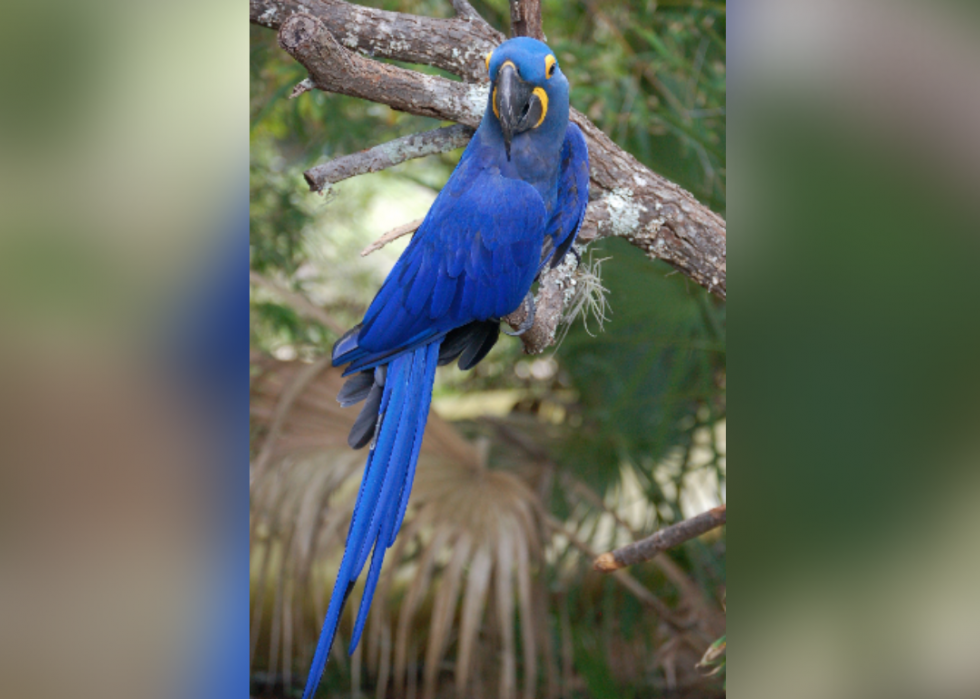
1 / 50
Eric Hersman // Wikimedia Eatables // Pictured: Anodorhynchus hyacinthinus
Glaucous macaw
- Scientific name: Anodorhynchus glaucus
- Red Listing status: Critically endangered
- Geographic range: Argentina, Brazil, Paraguay, Uruguay
- Threatened by: Residential & commercial development, agronomics & aquaculture, biological resource use
- Current conservation efforts: Conservation sites identified
- Citation: BirdLife International 2016. Anodorhynchus glaucus. The IUCN Ruby List of Threatened Species 2016: e.T22685527A93078084.
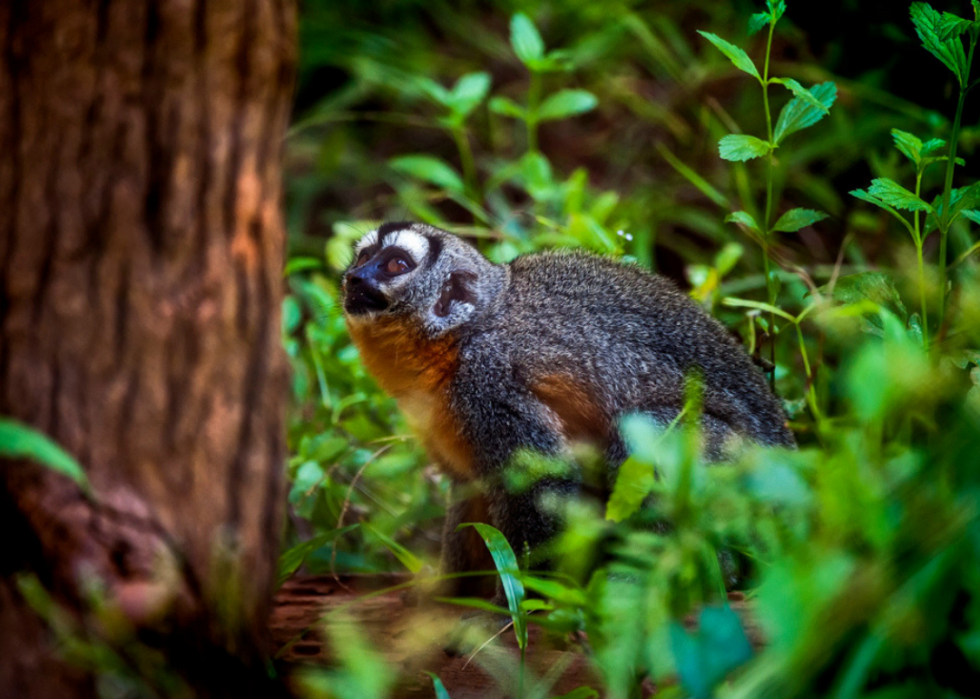
2 / 50
grupolosaraguatos // GBIF
Brumback's night monkey
- Scientific name: Aotus brumbacki
- Scarlet List condition: Vulnerable
- Geographic range: Colombia
- Threatened by: Residential & commercial development, agriculture & aquaculture, biological resource apply
- Current conservation efforts: Occurs in at least 1 protected area, included in international legislation, field of study to international management / merchandise controls
- Commendation: Morales-Jiménez, A.L., Link, A. & Stevenson, P. 2008. Aotus brumbacki. The IUCN Cerise List of Threatened Species 2008: e.T39915A10284518.
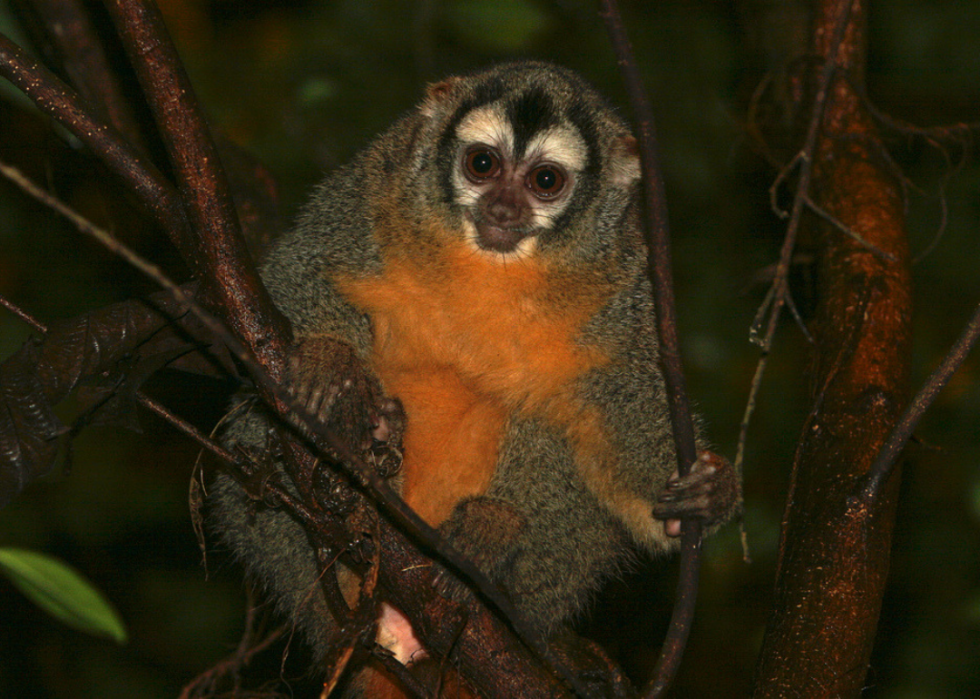
three / fifty
Mogens Trolle // Shutterstock
Nancy Ma's dark monkey
- Scientific proper name: Aotus nancymaae
- Cherry Listing status: Vulnerable
- Geographic range: Brazil (Amazonas), Colombia, Peru
- Threatened past: Agriculture & aquaculture, biological resource apply
- Current conservation efforts: Occurs in at least ane protected expanse, included in international legislation, subject to international management / trade controls
- Commendation: Maldonado, A., Guzman-Caro, D., Shanee, S., Defler, T.R. & Roncancio, N. 2017. Aotus nancymaae (amended version of 2017 assessment). The IUCN Blood-red List of Threatened Species 2017: e.T41540A121725532.
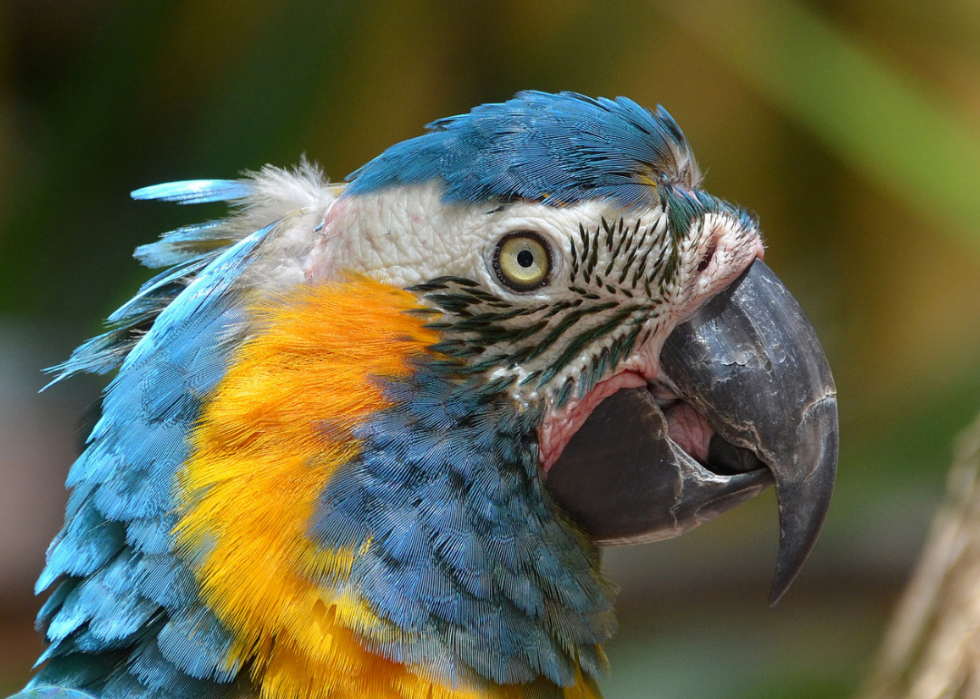
four / fifty
Clément Bardot // Wikimedia Commons
Blue-throated macaw
- Scientific proper name: Ara glaucogularis
- Ruddy List status: Critically endangered
- Geographic range: Republic of bolivia
- Threatened by: Biological resource apply, natural system modifications, invasive & other problematic species/genes/diseases, climate change & severe atmospheric condition
- Electric current conservation efforts: Action recovery program, conservation sites identified, field of study to ex-situ conservation, education & awareness programs, bailiwick to international management/trade controls
- Commendation: BirdLife International 2022. Ara glaucogularis. The IUCN Ruddy Listing of Threatened Species 2022: e.T22685542A130868462.
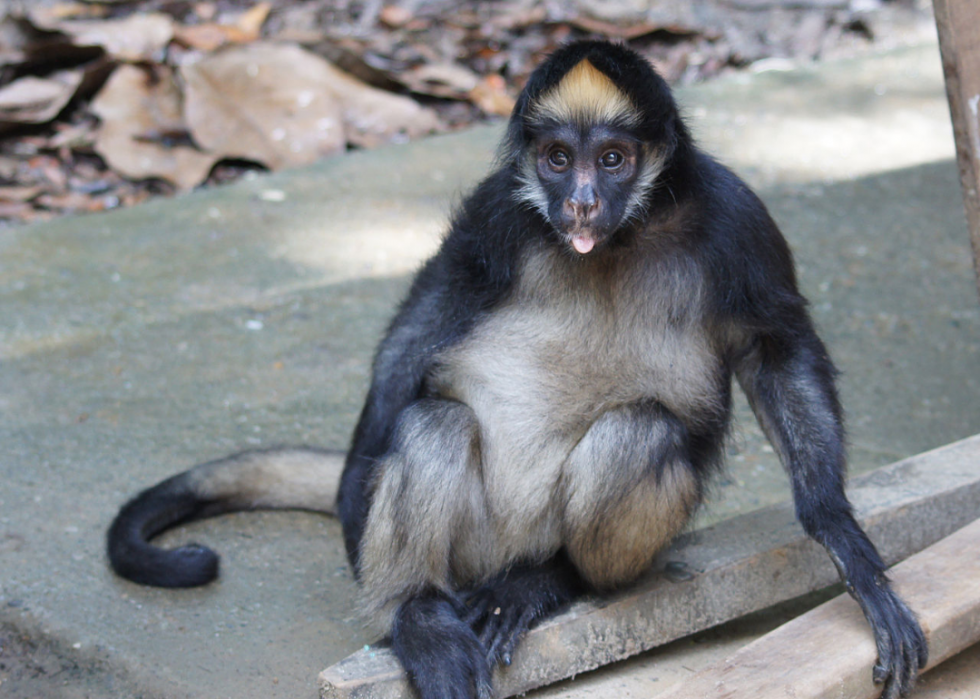
v / fifty
White-bellied spider monkey
- Scientific name: Ateles belzebuth
- Cherry List status: Endangered
- Geographic range: Brazil (Roraima, Amazonas), Colombia, Ecuador, Peru, Venezuela
- Threatened past: Residential & commercial development, agronomics & aquaculture, energy production & mining, biological resources use, natural system modifications
- Current conservation efforts: Conservation sites identified, discipline to education & sensation programs, included in international legislation, subject to any international management/merchandise controls
- Citation: Link, A., Muniz, C., Rylands, A.B., Mourthé, Í., Cornejo, F.M., Urbani, B., Mittermeier, R.A., Stevenson, P.R., Palacios, E., Boubli, J., Shanee, S., de la Torre, Southward. & Moscoso, P. 2022. Ateles belzebuth. The IUCN Red Listing of Threatened Species 2022: e.T2276A17928557.
You may also like: The but 7 countries that are on rail to meet the Paris Agreement—and how they're doing it
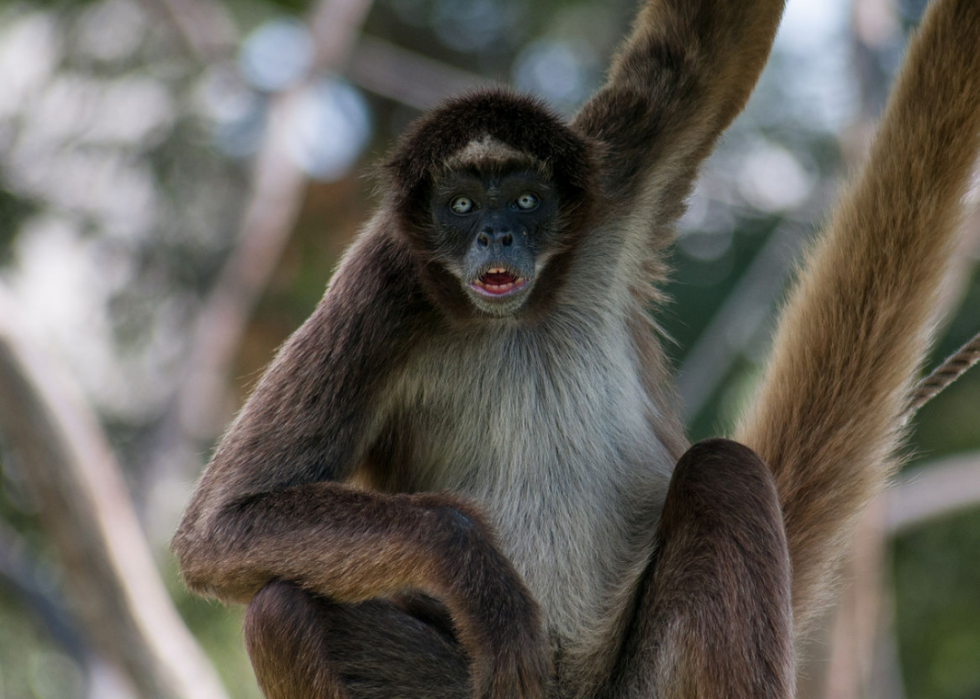
6 / 50
The Lensman // Wikimedia Commons
Variegated spider monkey
- Scientific proper name: Ateles hybridus
- Red List status: Critically endangered
- Geographic range: Colombia, Venezuela
- Threatened by: Residential & commercial development, agronomics & aquaculture, transportation & service corridors, biological resource employ
- Current conservation efforts: Occurs in at least i protected area, field of study to ex-situ conservation
- Citation: Urbani, B., Morales, A. L., Link, A. & Stevenson, P. 2008. Ateles hybridus. The IUCN Reddish List of Threatened Species 2008: e.T39961A10280054.
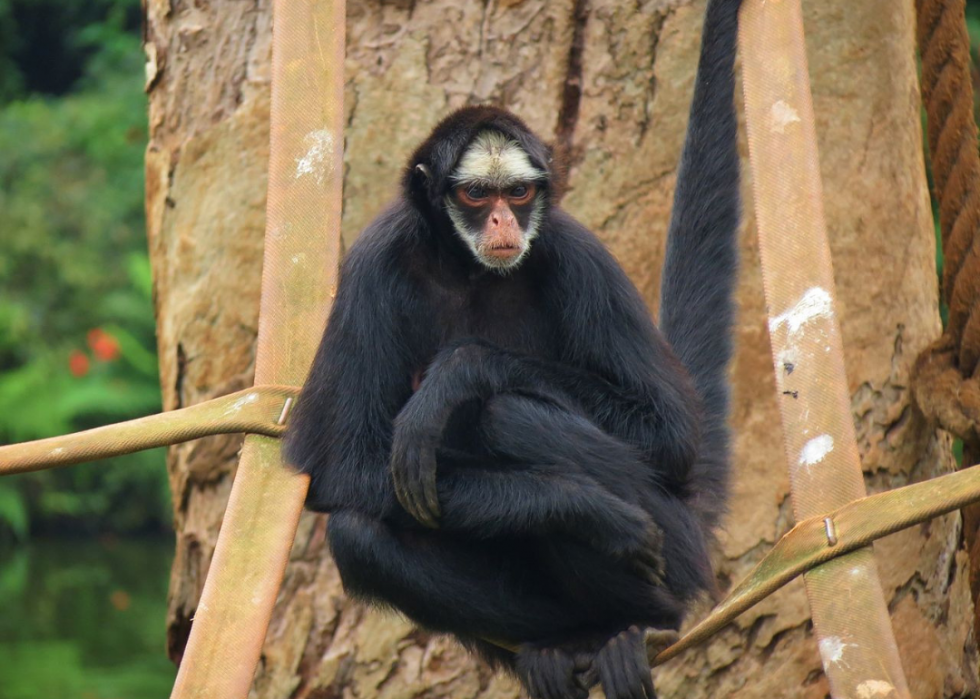
vii / 50
Miguelrangeljr // Wikimedia Eatables
White-cheeked spider monkey
- Scientific proper noun: Ateles marginatus
- Red List condition: Endangered
- Geographic range: Brazil (Mato Grosso, Pará)
- Threatened by: Residential & commercial development, agriculture & aquaculture, transportation & service corridors, biological resource apply
- Current conservation efforts: Occurs in at least one protected area, included in international legislation, subject to international direction / trade controls
- Commendation: Mittermeier, R.A., Boubli, J. & Di Fiore, A. 2022. Ateles marginatus. The IUCN Ruddy List of Threatened Species 2022: e.T2282A17929907.
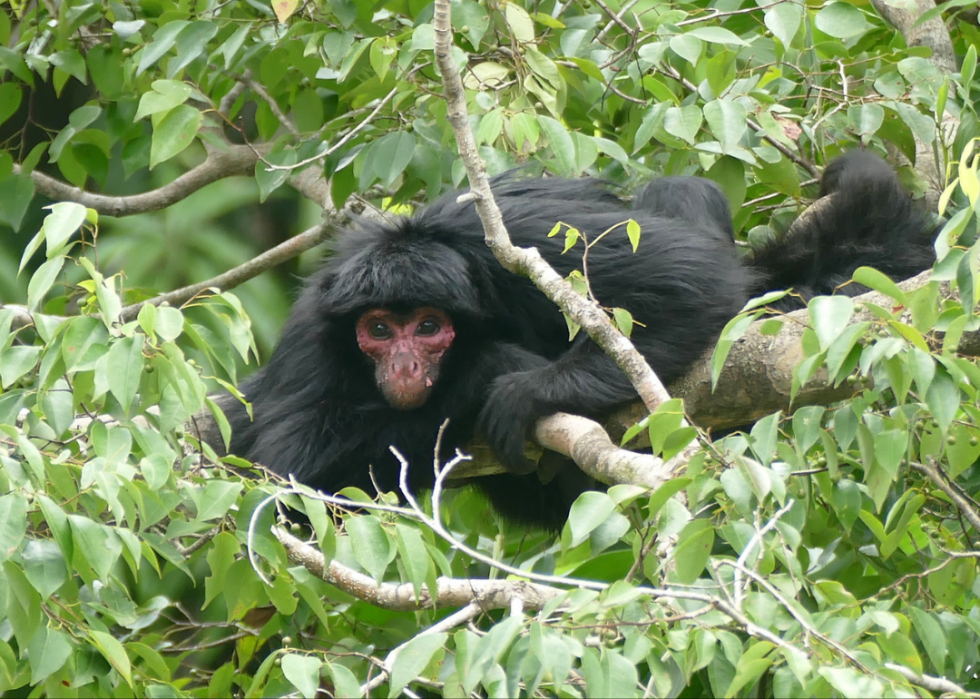
eight / 50
Guiana spider monkey
- Scientific proper noun: Ateles paniscus
- Ruby-red List status: Vulnerable
- Geographic range: Brazil (Roraima, Amapá, Pará), French Guiana, Republic of guyana, Suriname
- Threatened past: Agronomics & aquaculture, biological resources use
- Current conservation efforts: Occurs in at to the lowest degree one protected area, included in international legislation, subject field to international management / merchandise controls
- Citation: Mittermeier, R.A., Rylands, A.B. & Boubli, J. 2022. Ateles paniscus. The IUCN Scarlet List of Threatened Species 2022: due east.T2283A17929494.
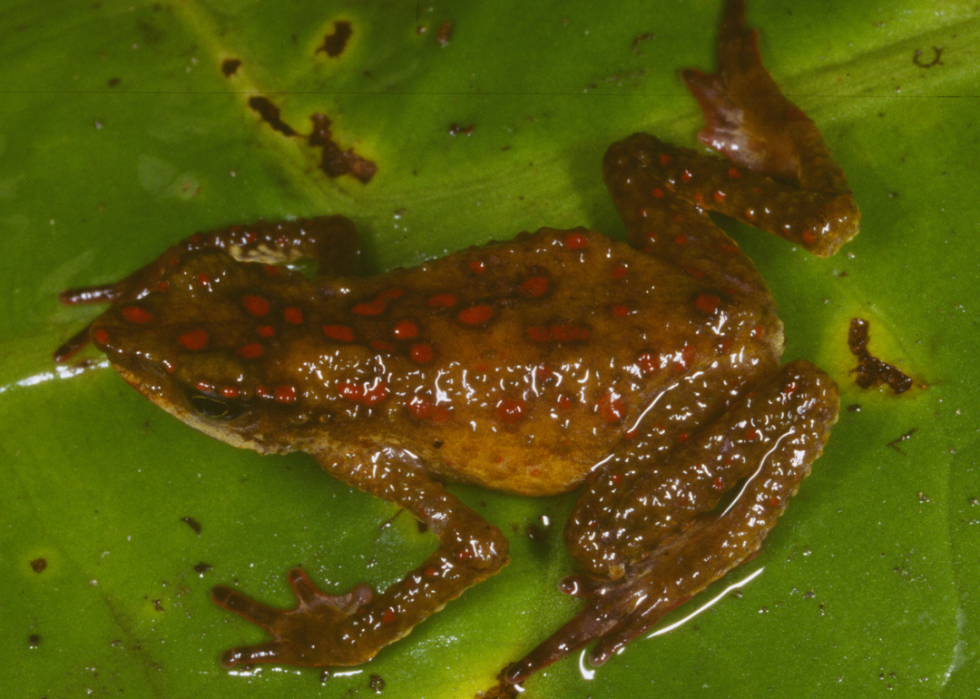
9 / 50
Alessandro Catenazzi // GBIF
Carabaya stubfoot toad
- Scientific name: Atelopus erythropus
- Red Listing status: Critically endangered
- Geographic range: Bolivia
- Threatened by: Invasive & other problematic species/genes/diseases
- Current conservation efforts: Occurs in at least one protected area
- Commendation: IUCN SSC Amphibian Specialist Grouping 2022. Atelopus erythropus. The IUCN Reddish List of Threatened Species 2022: e.T54506A89196113.

10 / 50
Dr. Kenneth Ichiro Miyata // GBIF // Pictured: Quito Stubfoot Toad
Morona-Santiago stubfoot toad
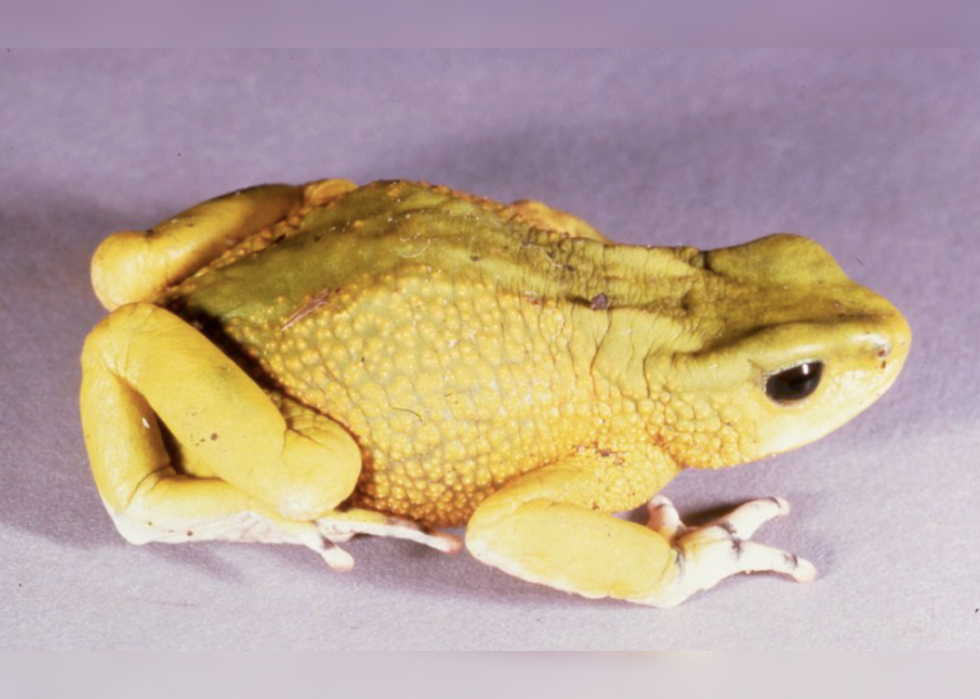
11 / 50
Dr. Kenneth Ichiro Miyata // GBIF
Quito stubfoot toad
- Scientific name: Atelopus ignescens
- Carmine List status: Critically endangered
- Geographic range: Ecuador
- Threatened by: Agronomics & aquaculture, natural arrangement modifications, invasive & other problematic species/genes/diseases, climatic change & astringent weather
- Current conservation efforts: Subject to ex-situ conservation
- Citation: IUCN SSC Amphibian Specialist Group 2022. Atelopus ignescens. The IUCN Reddish List of Threatened Species 2022: e.T54518A98641865.

12 / 50
Dr. Kenneth Ichiro Miyata // GBIF // Pictured: Longirostris harlequin toad
Gualecenita stubfoot toad
- Scientific proper noun: Atelopus nepiozomus
- Ruby List condition: Endangered
- Geographic range: Republic of ecuador
- Threatened by: Agriculture & aquaculture, invasive & other problematic species/genes/diseases
- Current conservation efforts: Occurs in at least one protected surface area
- Citation: IUCN SSC Amphibian Specialist Group 2022. Atelopus nepiozomus. The IUCN Red List of Threatened Species 2022: east.T54533A98642427.
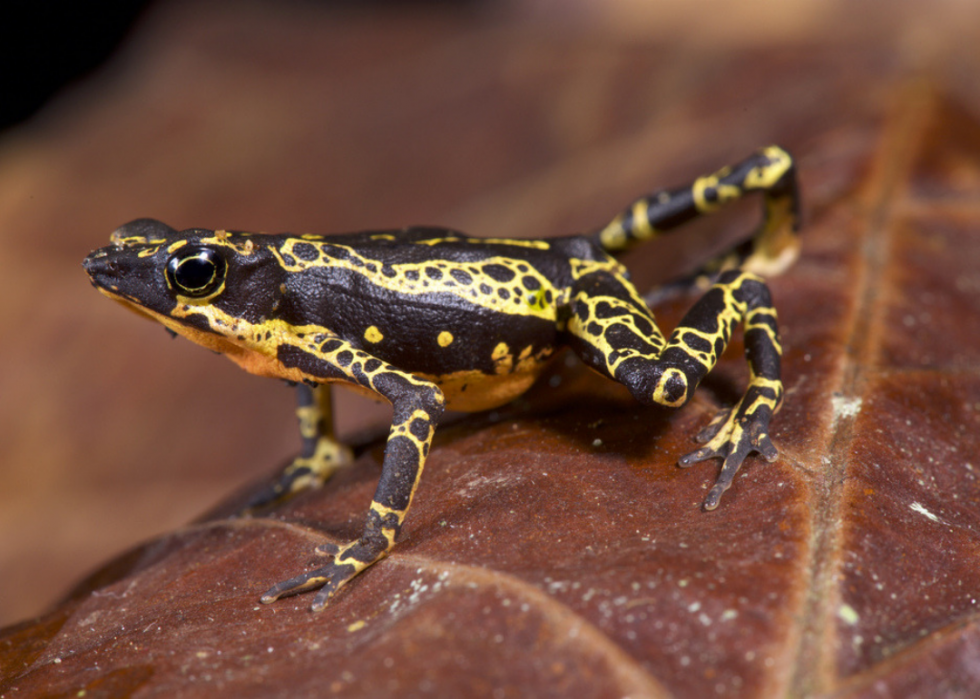
13 / l
reptiles4all // Shutterstock
Pebas stubfoot toad
- Scientific name: Atelopus spumarius
- Cherry-red List status: Vulnerable
- Geographic range: Brazil, Colombia, Ecuador, French Guiana, Guyana, Peru, Suriname
- Threatened past: Residential & commercial development, agronomics & aquaculture, transportation & service corridors, biological resource use, natural organisation modifications, invasive non-native/alien species/diseases
- Current conservation efforts: Conservation sites identified, occurs in at least one protected area, subject to ex-situ conservation
- Commendation: Claudia Azevedo-Ramos, Santiago Ron, Luis A. Coloma, Martín R. Bustamante, Antonio Salas, Rainer Schulte, Stefan Lötters, Ariadne Angulo, Fernando Castro, Jean Lescure, Christian Marty, Enrique La Marca, Marinus Hoogmoed 2010. Atelopus spumarius. The IUCN Red List of Threatened Species 2010: e.T54555A11166846.
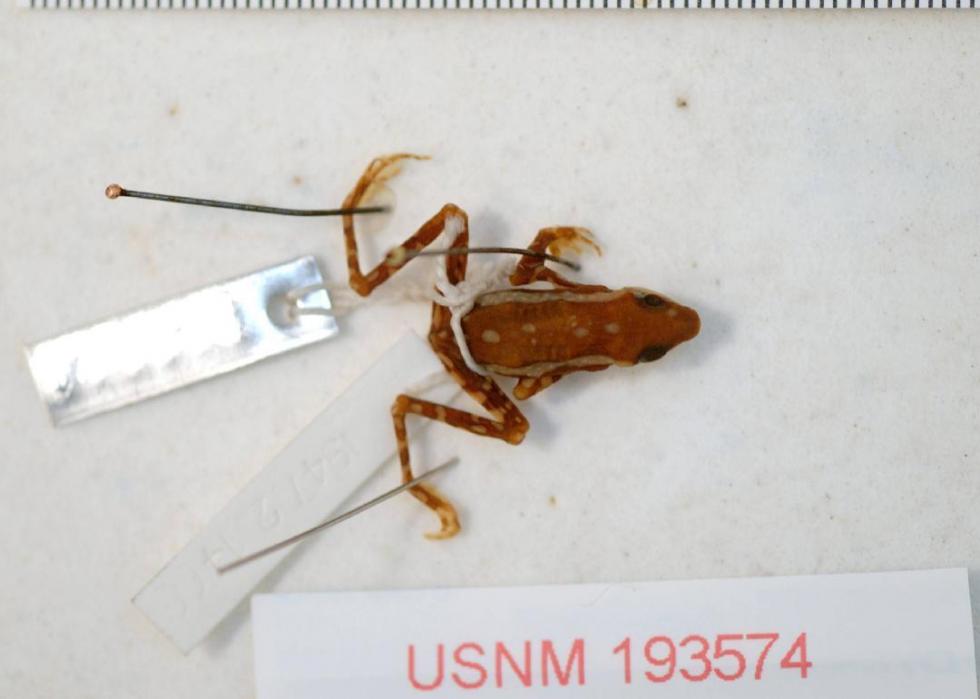
14 / 50
Jenna Welch // GBIF // Pictured: Atelopus tricolor
Bolivian stubfoot toad
- Scientific proper name: Atelopus tricolor
- Red Listing status: Vulnerable
- Geographic range: Bolivia, Peru
- Threatened by: Agriculture & aquaculture, invasive and other problematic species, genes & diseases, pollution
- Current conservation efforts: Conservation sites identified, occurs in at least one protected area
- Citation: Salas, A., Ibáñez, R., Catenazzi, A., Chaparro, J.C., Angulo, A., Reichle, S., Köhler, J., De la Riva, I., Lötters, S., Cortez, C. & Arizabal, Due west. 2004. Atelopus tricolor (errata version published in 2016). The IUCN Crimson Listing of Threatened Species 2004: east.T54559A86446362.
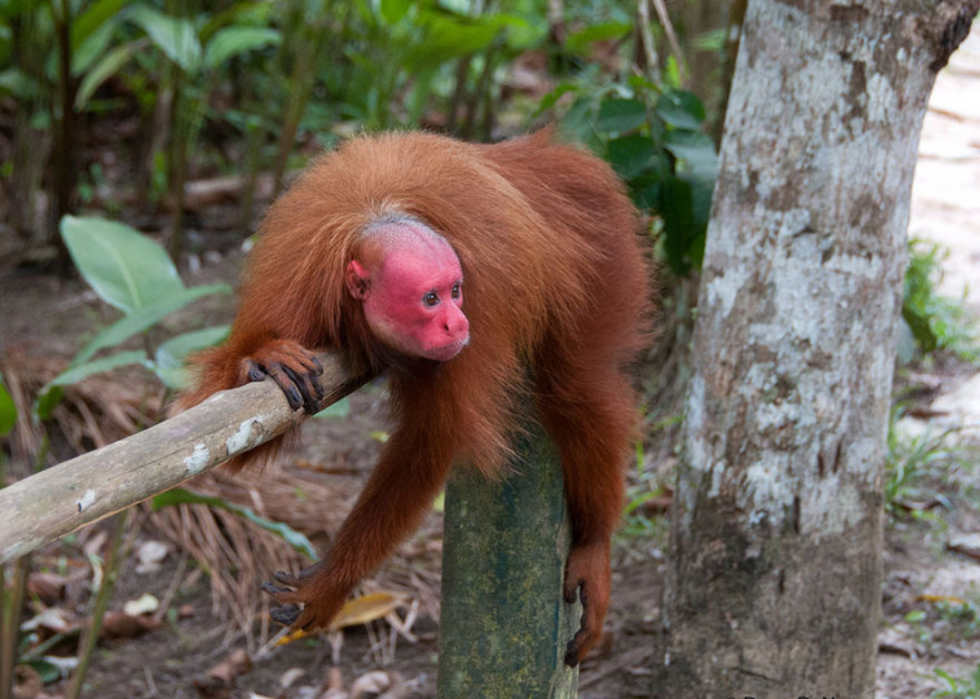
15 / 50
Doug DeNeve // Wikimedia Eatables
Bald-headed uakari
- Scientific proper name: Cacajao calvus
- Red List condition: Vulnerable
- Geographic range: Brazil, Peru
- Threatened by: Agriculture & aquaculture, biological resource use
- Current conservation efforts: Conservation sites identified, included in international legislation, subject area to whatever international management / trade controls
- Citation: Veiga, 50.One thousand., Bowler, M., Silva Jr., J.S., Queiroz, H.L., Boubli, J.-P. & Rylands, A.B. 2008. Cacajao calvus. The IUCN Crimson List of Threatened Species 2008: e.T3416A9846330.
Y'all may also similar: 25 endangered animals that only live in America
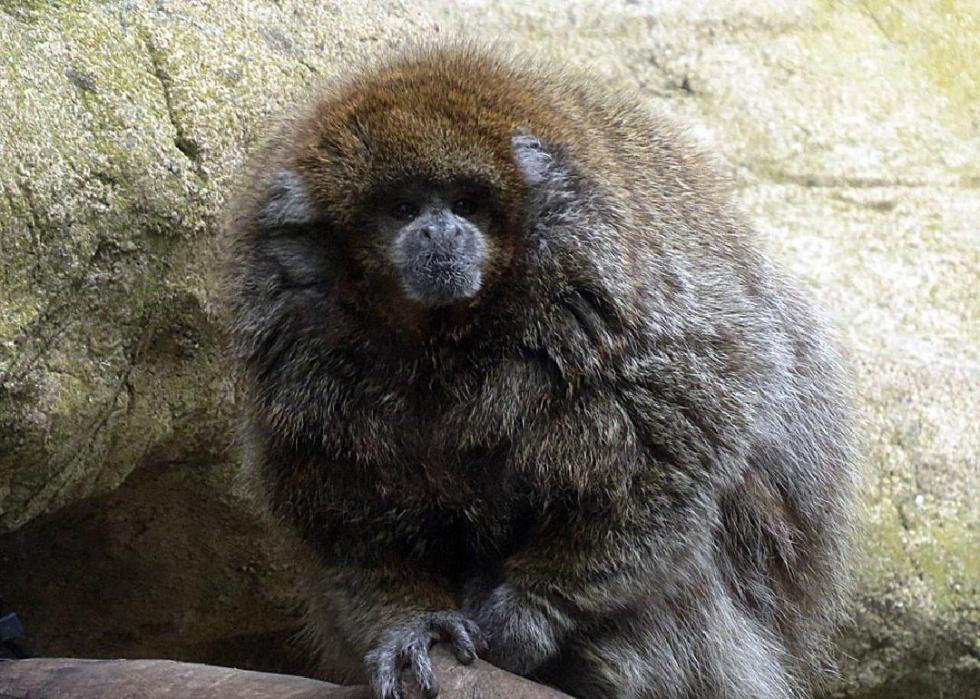
16 / fifty
Dick Culbert // Flickr // Pictured: White-eared Titi Monkey
San Martin titi monkey
- Scientific name: Callicebus oenanthe
- Carmine List status: Critically endangered
- Geographic range: Peru
- Threatened by: Residential & commercial development, agriculture & aquaculture, transportation & service corridors, biological resources utilize
- Current conservation efforts: Conservation sites identified, occurs in at least one protected expanse, recent pedagogy & awareness programs, included in international legislation, subject to international management / trade controls
- Citation: Veiga, L., Bóveda-Penalba, A., Vermeer, J., Tello-Alvarado, J.C. & Cornejo, F. 2011. Plecturocebus oenanthe. The IUCN Cherry List of Threatened Species 2011: e.T3553A9939083.
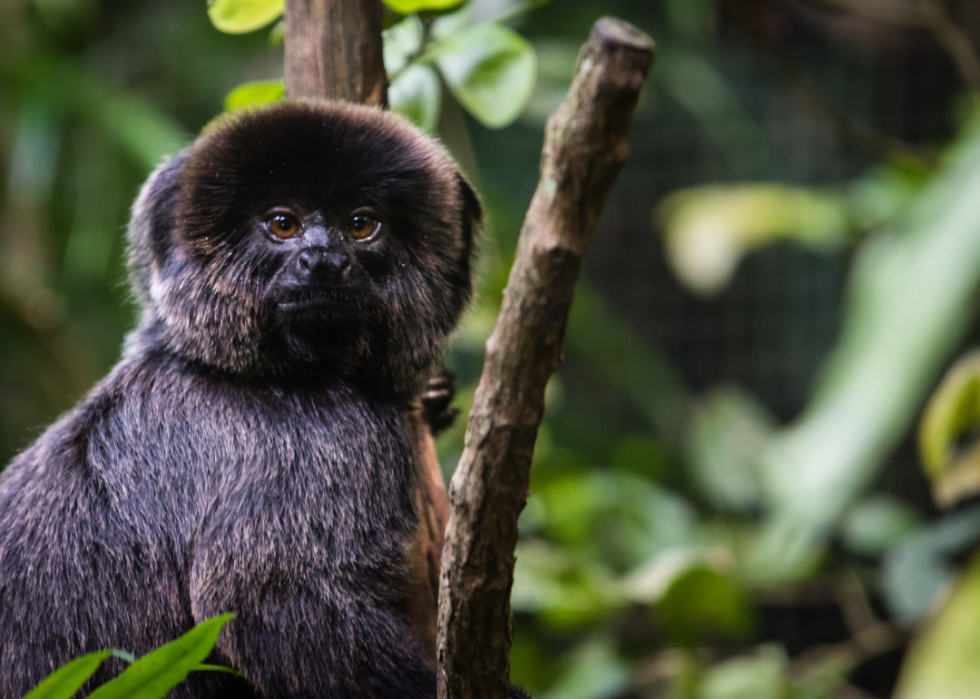
17 / 50
Goeldi's monkey
- Scientific name: Callimico goeldii
- Red List status: Vulnerable
- Geographic range: Republic of bolivia, Brazil (Amazonas, Acre, Rondônia), Colombia, Peru
- Threatened by: Agriculture & aquaculture, transportation & service corridors, biological resource use
- Current conservation efforts: Conservation sites identified, included in international legislation, discipline to international management / trade controls
- Citation: Cornejo, F. 2008. Callimico goeldii. The IUCN Cherry-red List of Threatened Species2008: due east.T3564A9947398.
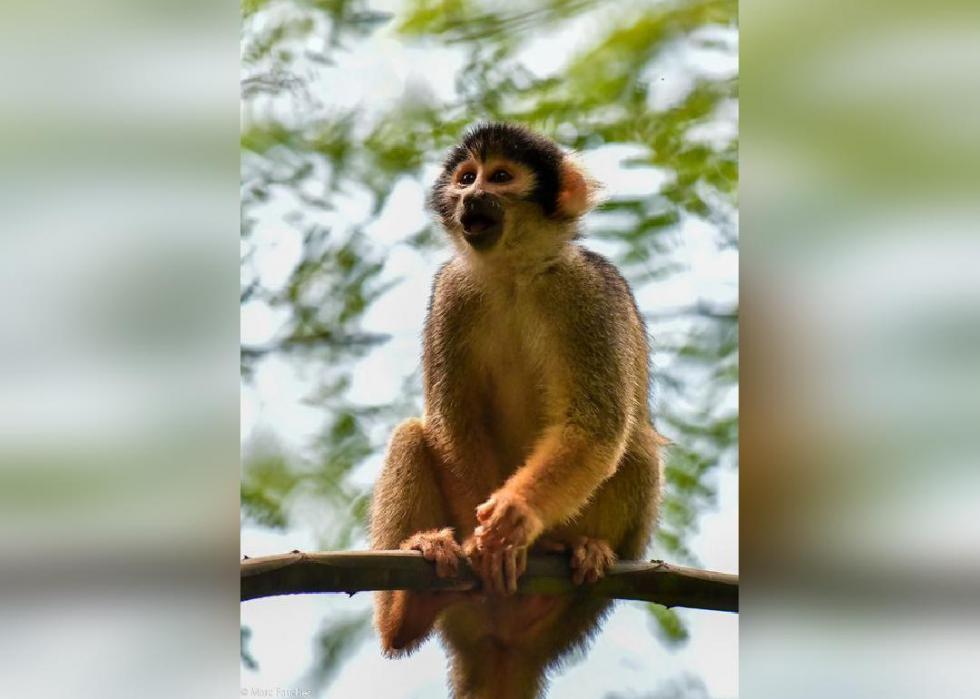
xviii / 50
pfaucher // iNaturalist // Pictured: Black-capped Squirrel Monkey
Ka'apor capuchin
- Scientific proper name: Cebus kaapori
- Red List condition: Critically endangered
- Geographic range: Brazil (Maranhão, Pará)
- Threatened by: Residential & commercial development, agriculture & aquaculture, energy production & mining, transportation & service corridors, biological resource use
- Current conservation efforts: Occurs in at least one protected area, included in international legislation, subject to international management / trade controls
- Commendation: Kierulff, M.C.M. & de Oliveira, M.M. 2008. Cebus kaapori. The IUCN Crimson List of Threatened Species 2008: e.T40019A10303725.
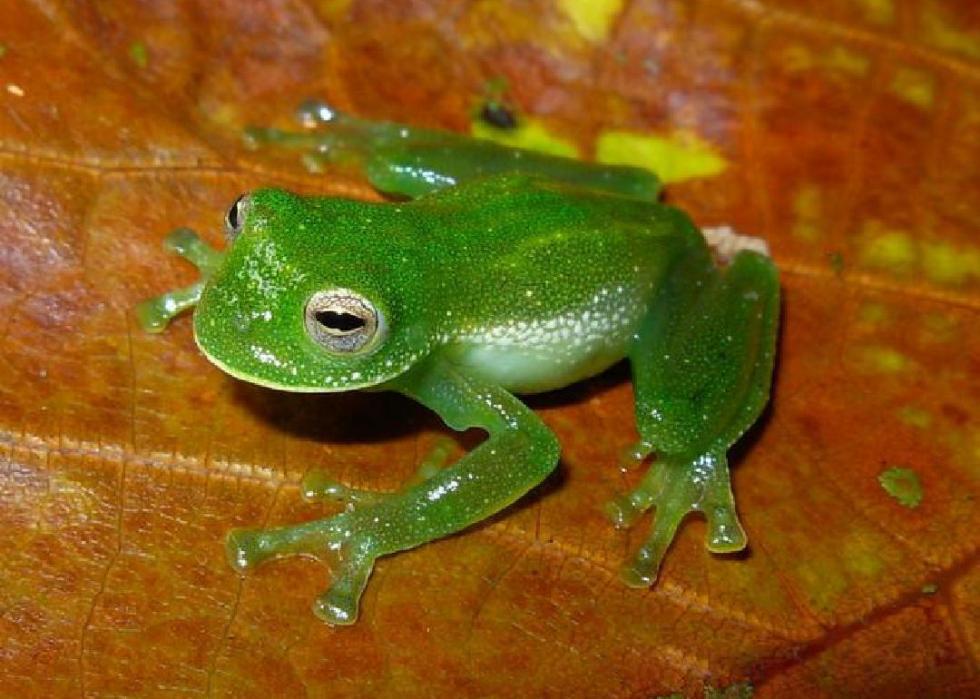
19 / fifty
Mauricio Rivera Correa // Wikimedia Commons // Pictured: Centrolene altitudinale
Amazon giant glass frog
- Scientific name: Centrolene pipilatum
- Red List status: Endangered
- Geographic range: Ecuador
- Threatened by: Agronomics & aquaculture, biological resource use, invasive & other problematic species/genes/diseases, climatic change & astringent weather
- Current conservation efforts: Occurs in at least ane protected area
- Citation: Luis A. Coloma, Santiago Ron, Diego Cisneros-Heredia 2004. Centrolene pipilatum. The IUCN Red List of Threatened Species 2004: e.T54933A11228482.
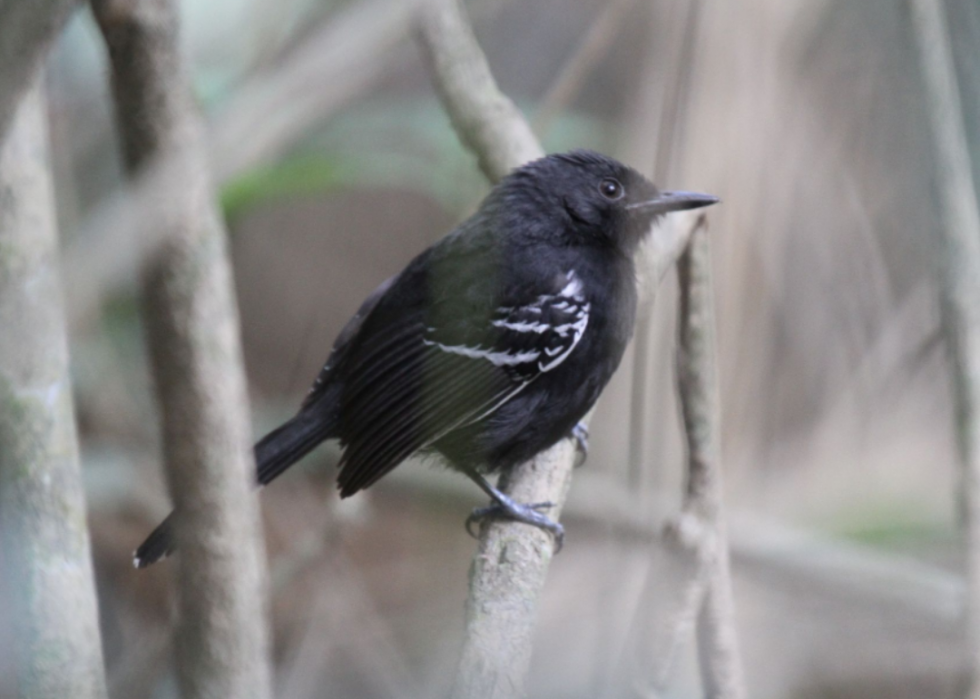
20 / fifty
Rio Branco antbird
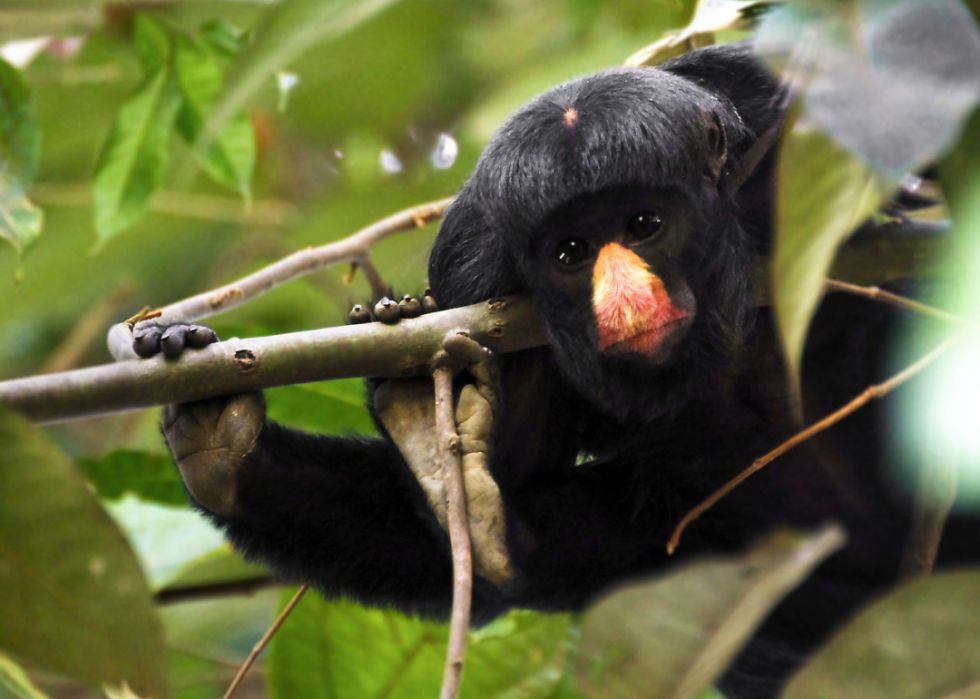
21 / 50
Valdir Hobus // Wikimedia Commons
White-nosed saki
- Scientific proper noun: Chiropotes albinasus
- Red List condition: Endangered
- Geographic range: Brazil
- Threatened by: Residential & commercial evolution, agriculture & aquaculture, transportation & service corridors, biological resource use
- Current conservation efforts: Conservation sites identified, included in international legislation, field of study to whatever international management / trade controls
- Citation: Veiga, L.M., Pinto, L.P., Ferrari, S.F., Rylands, A.B., Mittermeier, R.A. & Boubli, J.-P. 2008. Chiropotes albinasus. The IUCN Blood-red Listing of Threatened Species 2008: e.T4685A11085894.

22 / fifty
WolfmanSF // Wikimedia Commons
Black bearded saki
- Scientific name: Chiropotes satanas
- Red List status: Critically endangered
- Geographic range: Brazil
- Threatened by: Residential & commercial development, agronomics & aquaculture, biological resource use, natural system modifications
- Current conservation efforts: Occurs in at to the lowest degree ane protected expanse, included in international legislation, subject to international management / merchandise controls
- Citation: Veiga, Fifty.M., Silva Jr., J.S., Ferrari, Southward.F. & Rylands, A.B. 2008. Chiropotes satanas. The IUCN Red List of Threatened Species 2008: e.T39956A10297662.
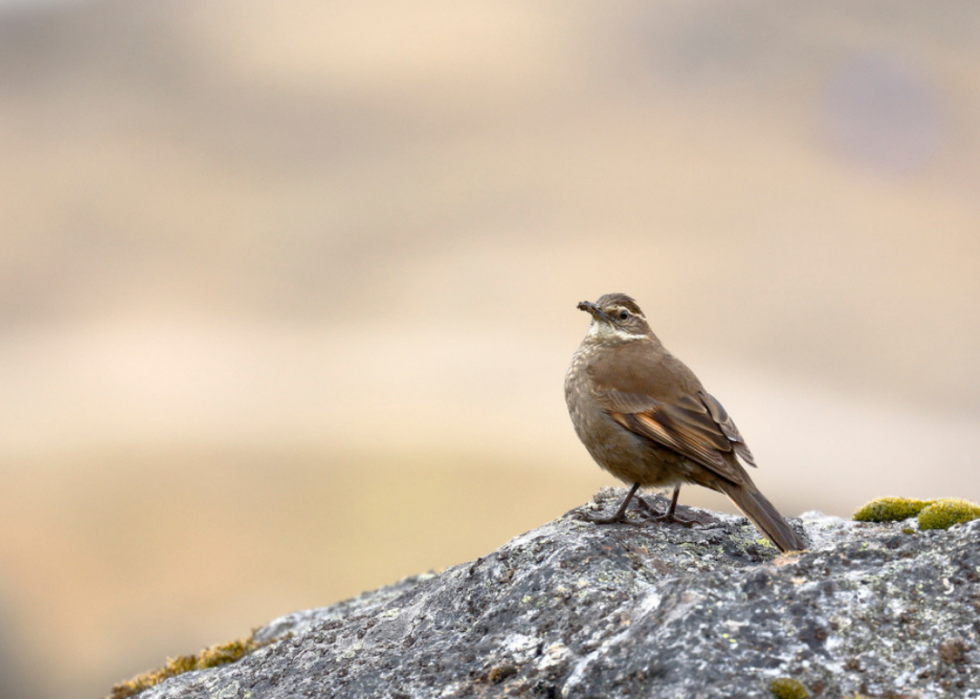
23 / fifty
Jonathan Chancasana // Shutterstock
Royal cinclodes
- Scientific proper noun: Cinclodes aricomae
- Ruddy List status: Critically endangered
- Geographic range: Peru
- Threatened by: Agronomics & aquaculture, biological resource use, human intrusions & disturbance, natural system modifications, pollution, climate change & astringent weather condition
- Electric current conservation efforts: Action recovery plan, conservation sites identified, occurs in at least i protected area
- Citation: BirdLife International 2022. Cinclodes aricomae (amended version of 2017 assessment). The IUCN Red List of Threatened Species 2022: e.T22724402A128905948.
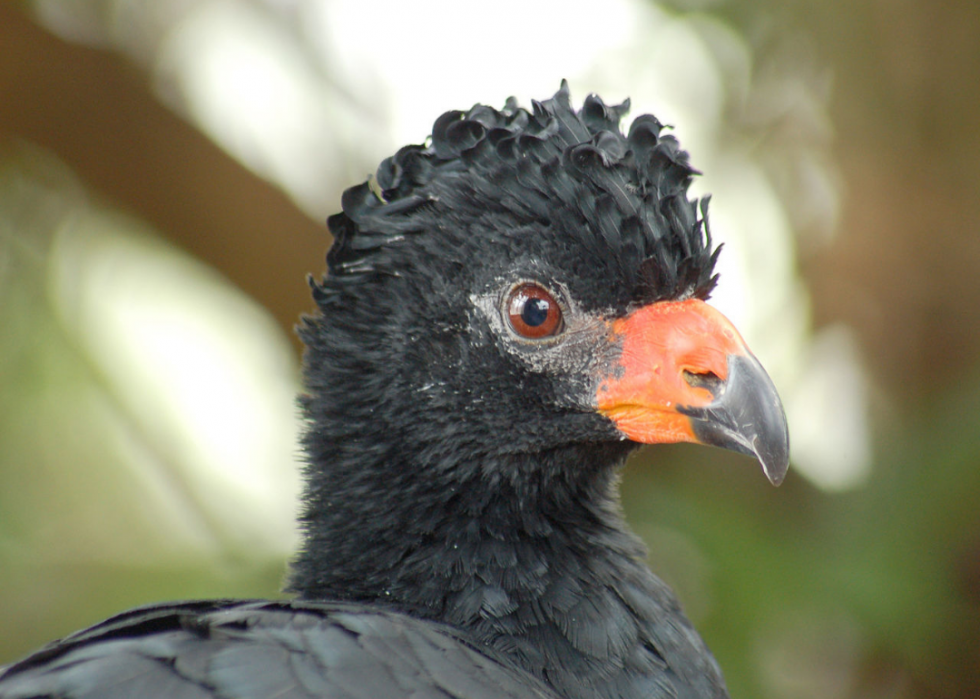
24 / 50
Derek Ramsey // Wikimedia Commons
Wattled curassow
- Scientific name: Crax globulosa
- Red Listing status: Endangered
- Geographic range: Peru
- Threatened past: Residential & commercial evolution, agriculture & aquaculture, biological resource utilise
- Current conservation efforts: Action recovery plan, conservation sites identified, occurs in at least one protected surface area, subjct to ex-situ conservation, bailiwick to education & awareness programs
- Citation: BirdLife International 2016. Crax globulosa. The IUCN Red List of Threatened Species 2016: east.T22678537A92777596.
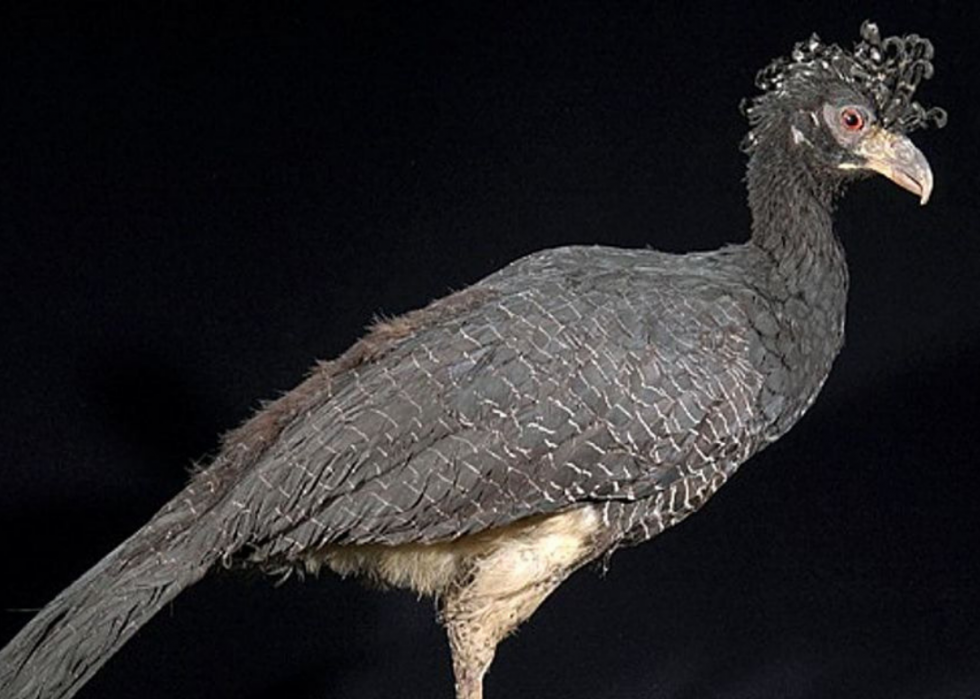
25 / 50
Unknown // Wikimedia Commons
Belem curassow
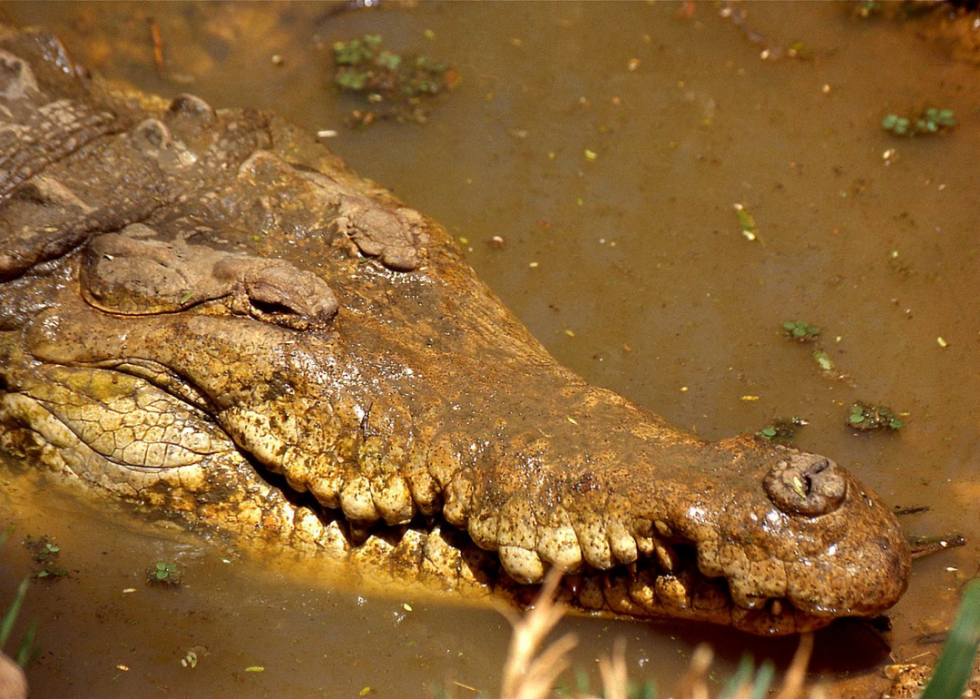
26 / 50
Bernard DUPONT // Wikimedia Commons
Orinoco crocodile
- Scientific name: Crocodylus intermedius
- Ruby-red Listing status: Critically endangered
- Geographic range: Colombia, Venezuela
- Threatened by: Agronomics & aquaculture, biological resource utilise
- Current conservation efforts: Action recovery plan, conservation sites identified, field of study to ex-situ conservation, successfully reintroduced
- Citation: Balaguera-Reina, S.A., Espinosa-Blanco, A., Antelo, R., Morales-Betancourt, K. & Seijas, A. 2022. Crocodylus intermedius. The IUCN Blood-red List of Threatened Species 2022: due east.T5661A3044743.
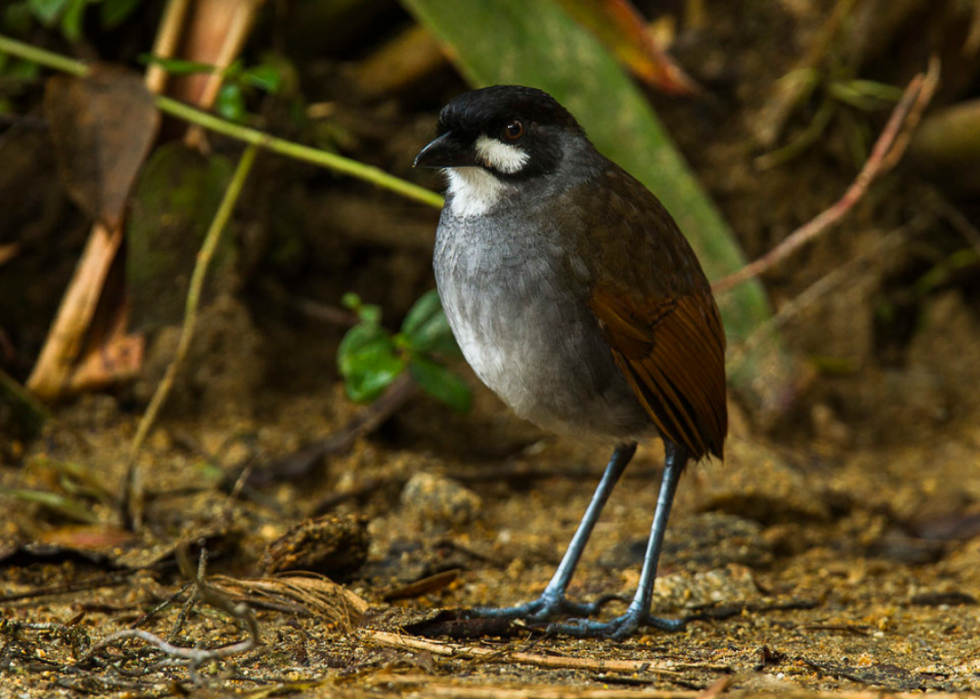
27 / 50
Francesco Veronesi // Flickr
Jocotoco antpitta
- Scientific name: Grallaria ridgelyi
- Red List status: Endangered
- Geographic range: Ecuador, Peru
- Threatened by: Residential & commercial development, agriculture & aquaculture, energy production & mining, transportation & service corridors, biological resource use
- Current conservation efforts: Conservation sites identified, occurs in at least one protected area
- Commendation: BirdLife International 2016. Grallaria ridgelyi. The IUCN Cherry List of Threatened Species 2016: e.T22724628A94874688.
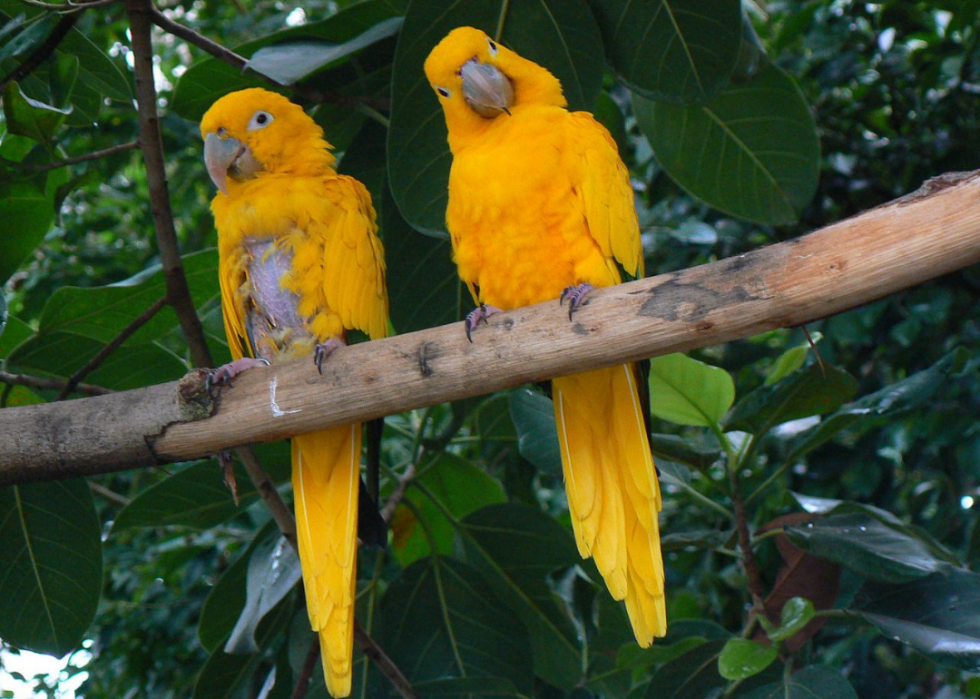
28 / fifty
Benny Mazur // Wikimedia Commons
Aureate parakeet
- Scientific proper noun: Guaruba guarouba
- Red List status: Vulnerable
- Geographic range: Brazil
- Threatened by: Residential & commercial development, transportation & service corridors, biological resources use
- Current conservation efforts: Activeness recovery plan, conservation sites identified, occurs in at least one protected expanse, field of study to ex-situ conservation, discipline to international management / trade controls
- Citation: BirdLife International 2022. Guaruba guarouba. The IUCN Ruby List of Threatened Species 2022: e.T22724703A132029835.
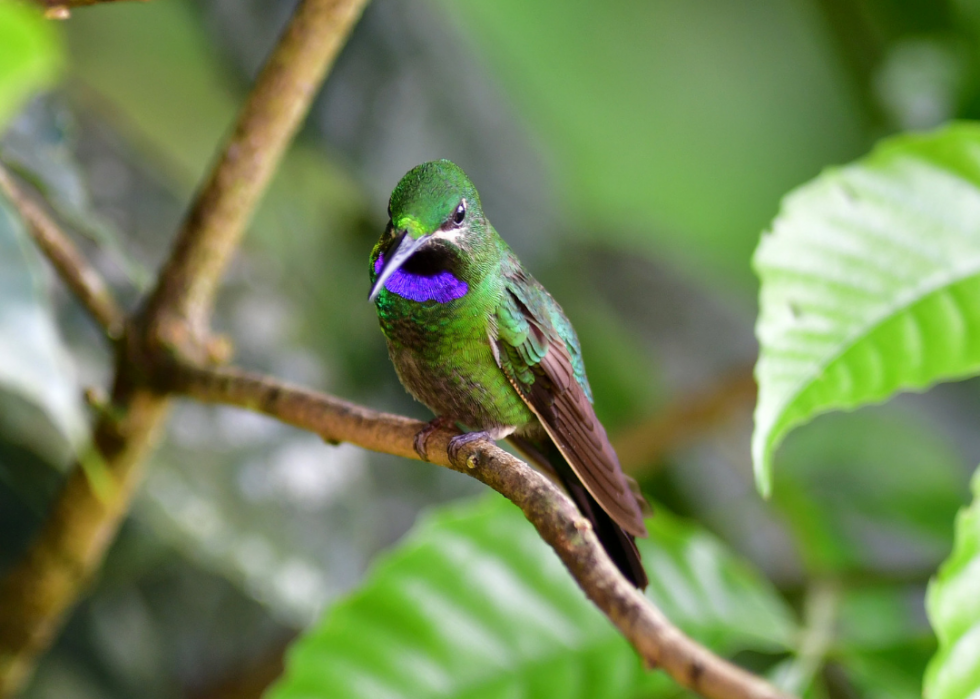
29 / 50
Panegyrics of Granovetter // Flickr
Pink-throated vivid
- Scientific proper name: Heliodoxa gularis
- Carmine Listing status: Vulnerable
- Geographic range: Colombia, Ecuador, Peru
- Threatened past: Agriculture & aquaculture, free energy production & mining, biological resource employ
- Current conservation efforts: Conservation sites identified, occurs in at least 1 protected area, bailiwick to international management / trade controls
- Citation: BirdLife International 2016. Heliodoxa gularis. The IUCN Ruby List of Threatened Species 2016: e.T22687721A93165925.
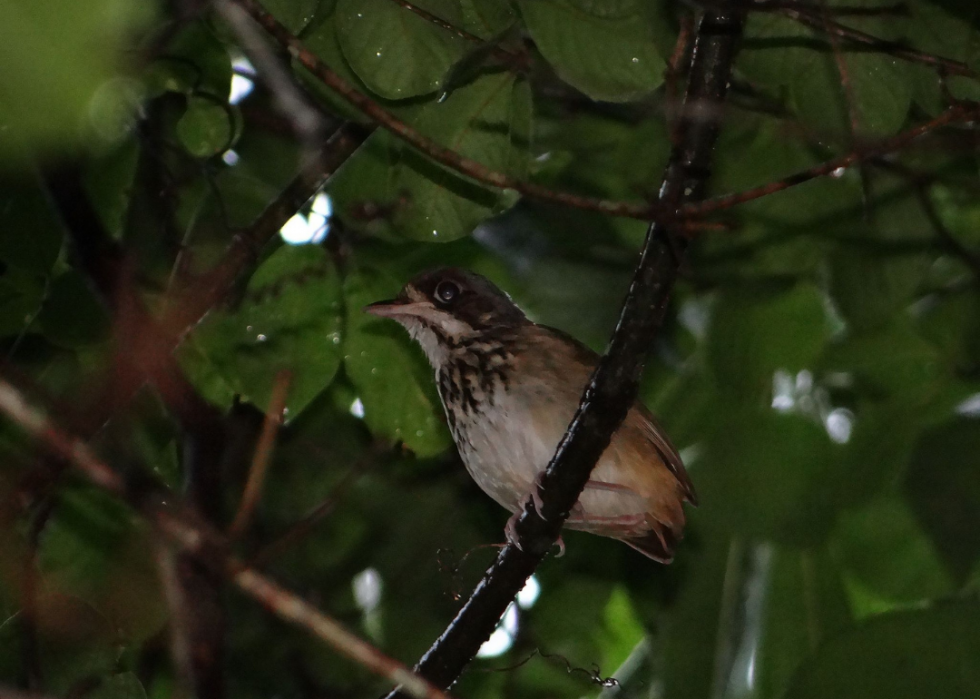
30 / l
Vincent A. Vos // iNaturalist
Masked antpitta
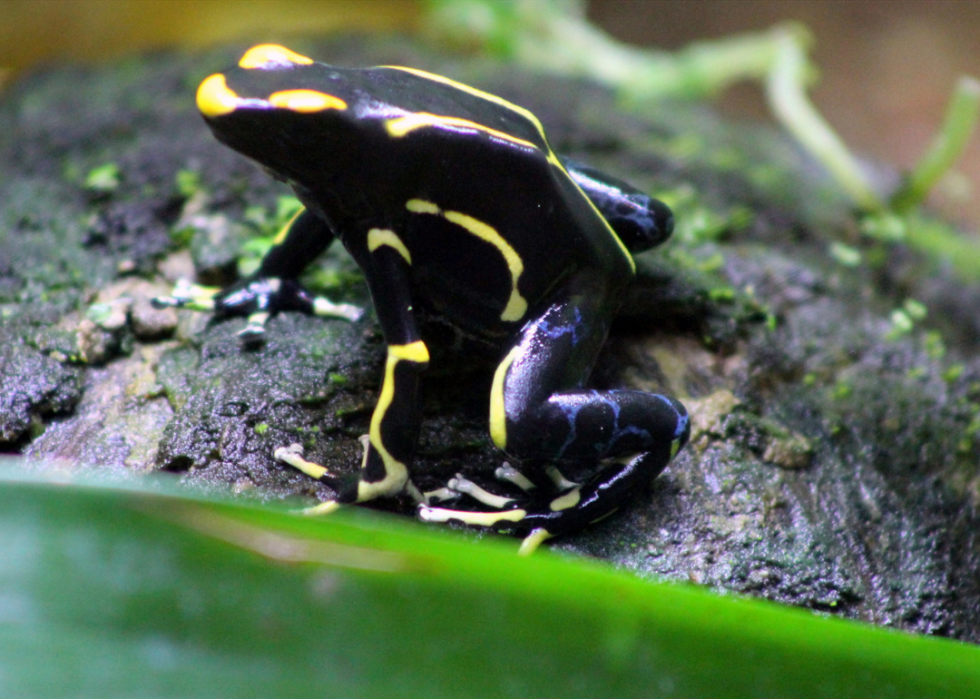
31 / 50
Sky blue poison dart frog
- Scientific proper noun: Hyloxalus azureiventris
- Crimson List status: Endangered
- Geographic range: Peru
- Threatened by: Residential & commercial development, agriculture & aquaculture, biological resource use
- Current conservation efforts: Occurs in at least one protected area, included in international legislation, subject to international management / trade controls
- Citation: IUCN SSC Amphibian Specialist Grouping 2022. Hyloxalus azureiventris. The IUCN Red List of Threatened Species 2022: due east.T55169A89200449.
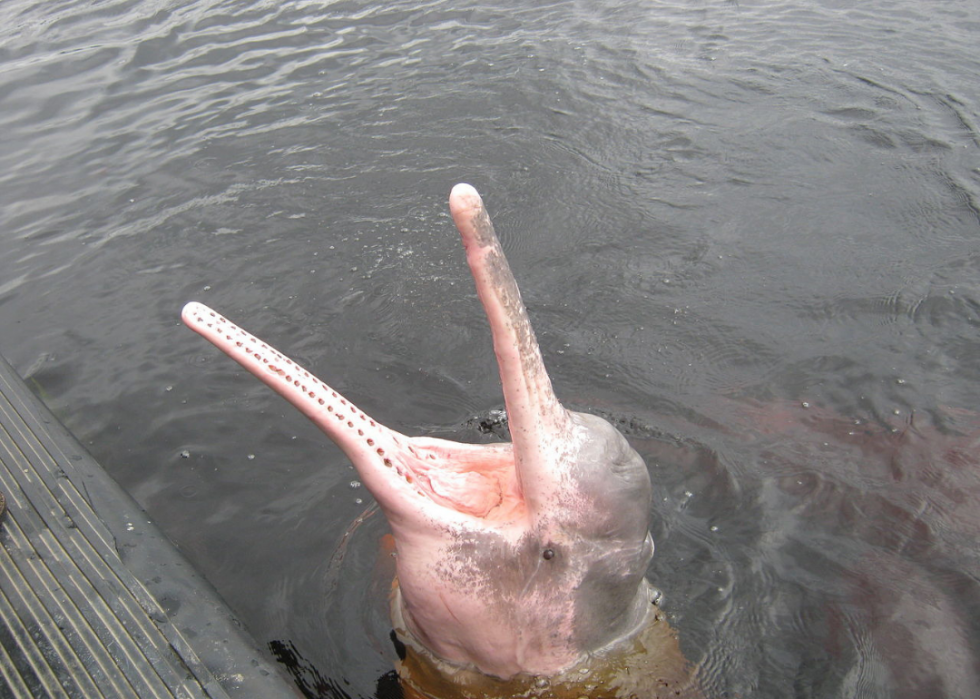
32 / 50
Jorge Andrade // Wikimedia Commons
Amazon river dolphin
- Scientific proper noun: Inia geoffrensis
- Red List status: Endangered
- Geographic range: Bolivia, Brazil, Colombia, Ecuador, Peru, Venezuela
- Threatened by: Residential & commercial development, energy production & mining, biological resource use, human intrusions & disturbnce, natural organization modifications, pollution
- Electric current conservation efforts: Action recovery plan, conservation sites identified, occurs in at least ane protected area, included in international legislation, field of study to whatever international management / trade controls
- Citation: da Silva, Five., Trujillo, F., Martin, A., Zerbini, A.North., Crespo, East., Aliaga-Rossel, Due east. & Reeves, R. 2022. Inia geoffrensis. The IUCN Cerise List of Threatened Species 2022: e.T10831A50358152.
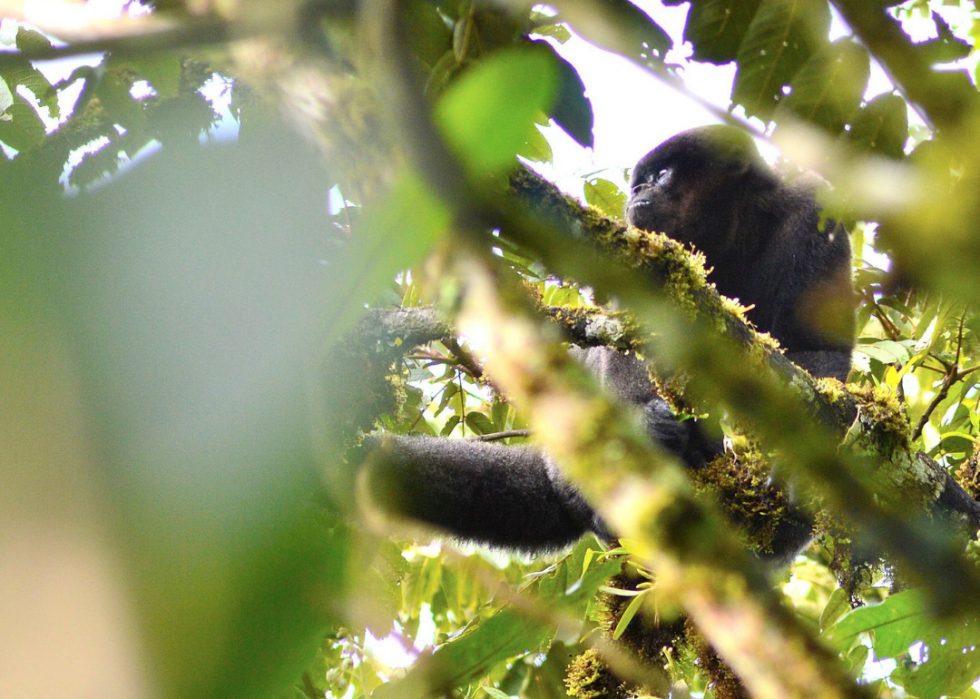
33 / fifty
Robby Deans // iNaturalist
Lagothrix lugens
- Scientific proper name: Lagothrix lugens
- Red List status: Critically endangered
- Geographic range: Republic of colombia
- Threatened by: Residential & commercial development, agriculture & aquaculture, transportation & service corridors, biological resource use
- Electric current conservation efforts: Occurs in at least one protected area, included in international legislation, subject to international management / trade controls
- Citation: Stevenson, P. & Link, A. 2008. Lagothrix lugens. The IUCN Scarlet List of Threatened Species 2008: e.T39926A10289596.
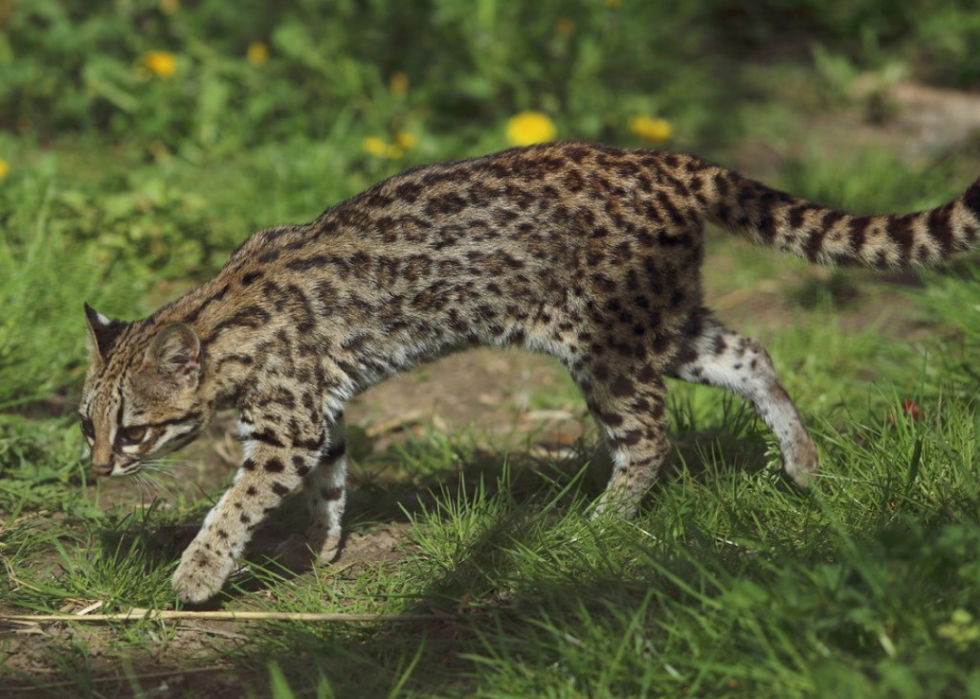
34 / 50
Groumfy69 // Wikimedia Eatables
Southern tiger cat
- Scientific name: Leopardus guttulus
- Ruddy List status: Vulnerable
- Geographic range: Argentina, Brazil, Paraguay
- Threatened by: Residential & commercial evolution, agriculture & aquaculture, transportation & service corridors, biological resources use, natural organization modifications, invasive non-native/conflicting species/diseases
- Electric current conservation efforts: Conservation sites identified, area based regional management plan, occurs in at least one protected surface area, contempo education & awareness programs
- Commendation: de Oliveira, T., Trigo, T., Tortato, M., Paviolo, A., Bianchi, R. & Leite-Pitman, M.R.P. 2016. Leopardus guttulus. The IUCN Red List of Threatened Species2016: due east.T54010476A54010576.
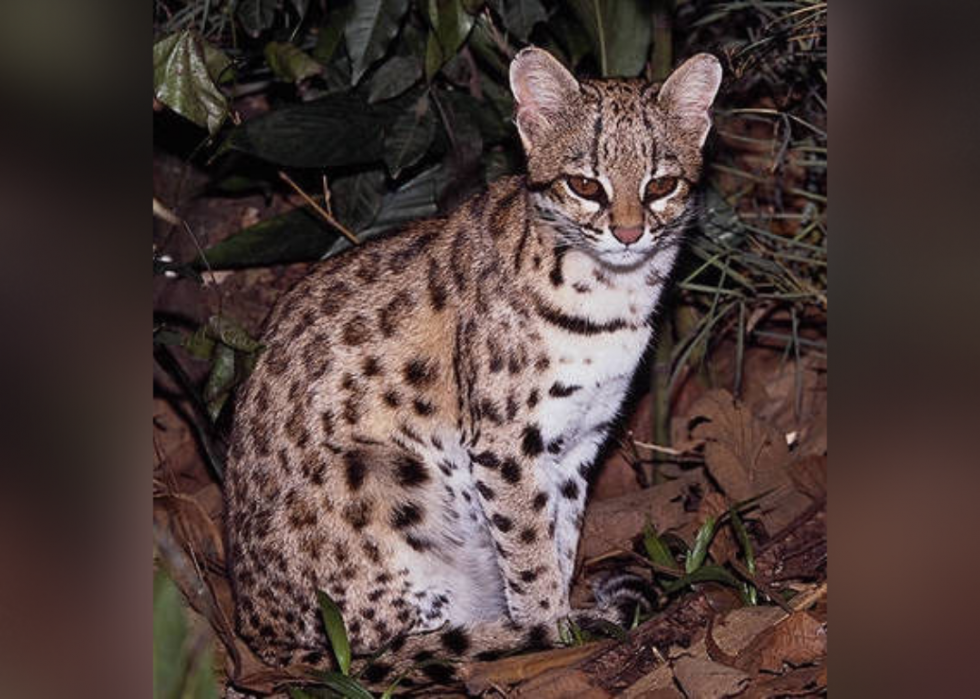
35 / fifty
tigrillagardenia // Flickr
Northern tiger cat
- Scientific name: Leopardus tigrinus
- Ruby-red List condition: Vulnerable
- Geographic range: Bolivia, Brazil, Colombia, Costa Rica, Ecuador, French Guiana, Guyana, Panama, Peru, Suriname, Venezuela
- Threatened past: Residential & commercial development, agriculture & aquaculture, energy production & mining, transportation & service corridors, biological resource use, natural system modifications, invasive non-native/alien species/diseases, pollution
- Current conservation efforts: Conservation sites identified, occurs in at to the lowest degree i protected area, included in international legislation, discipline to international management / trade controls
- Citation: Payan, E. & de Oliveira, T. 2016. Leopardus tigrinus. The IUCN Cherry List of Threatened Species 2016: due east.T54012637A50653881.
You may also like: How communities are dealing with invasive species beyond the U.Due south.
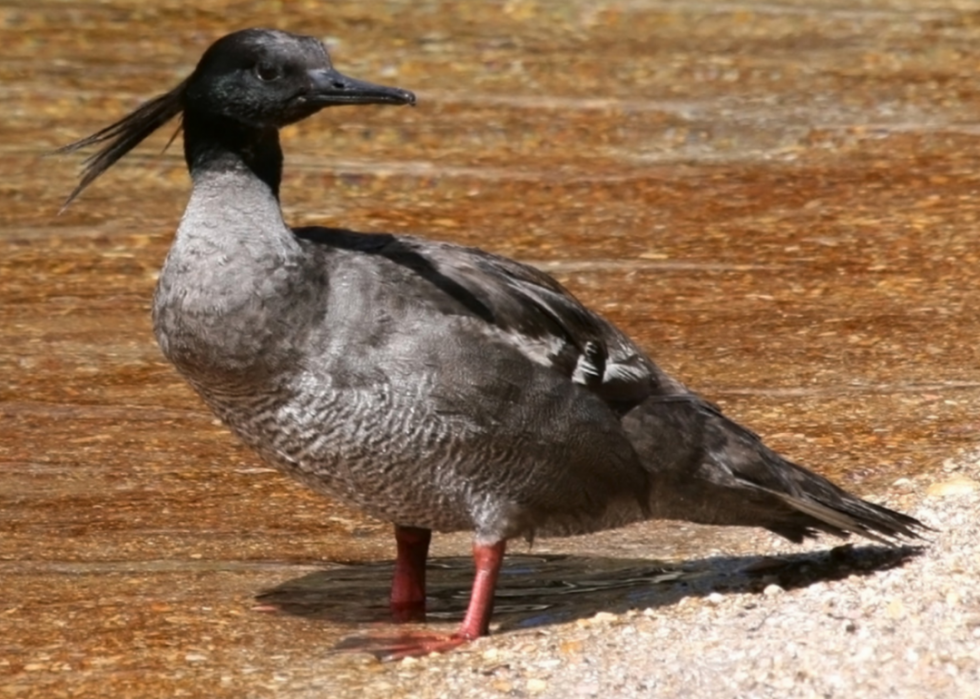
36 / 50
Prof. Sávio Freire Bruno // Wikimedia Commons
Brazilian merganser
- Scientific name: Mergus octosetaceus
- Red Listing status: Critically endangered
- Geographic range: Argentina, Brazil, Paraguay, Uruguay
- Threatened by: Agriculture & aquaculture, energy product & mining, biological resource use, human intrusions & disturbance, natural system modifications, pollution
- Electric current conservation efforts: Action recovery plan, conservation sites identified, occurs in at to the lowest degree one protected area, subject to ex-situ conservation, recent education & awareness programs
- Citation: BirdLife International 2022. Mergus octosetaceus (amended version of 2016 cess). The IUCN Cerise List of Threatened Species 2022: e.T22680482A123509847.
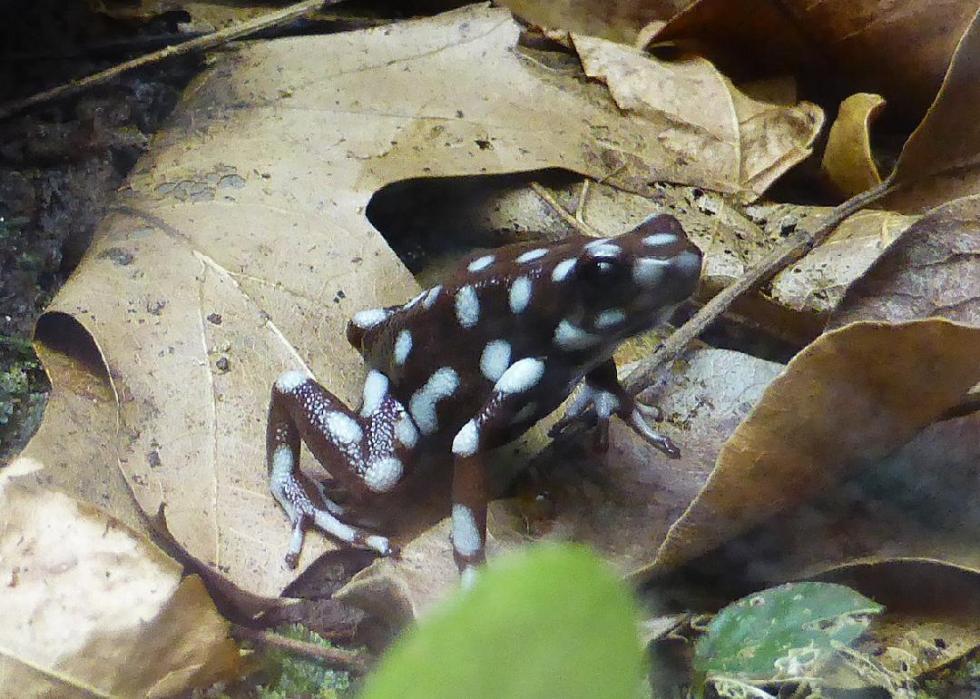
37 / l
Totodu74 // Wikimedia Eatables // Pictured: Excidobates mysteriosus
Minyobates steyermarki
- Scientific name: Minyobates steyermarki
- Blood-red List condition: Critically endangered
- Geographic range: Venezuela
- Threatened by: Free energy production & mining, biological resource use, pollution
- Electric current conservation efforts: Occurs in at to the lowest degree 1 protected area
- Citation: Enrique La Marca, Celsa Señaris 2004. Minyobates steyermarki. The IUCN Red Listing of Threatened Species 2004: east.T55202A11264562.
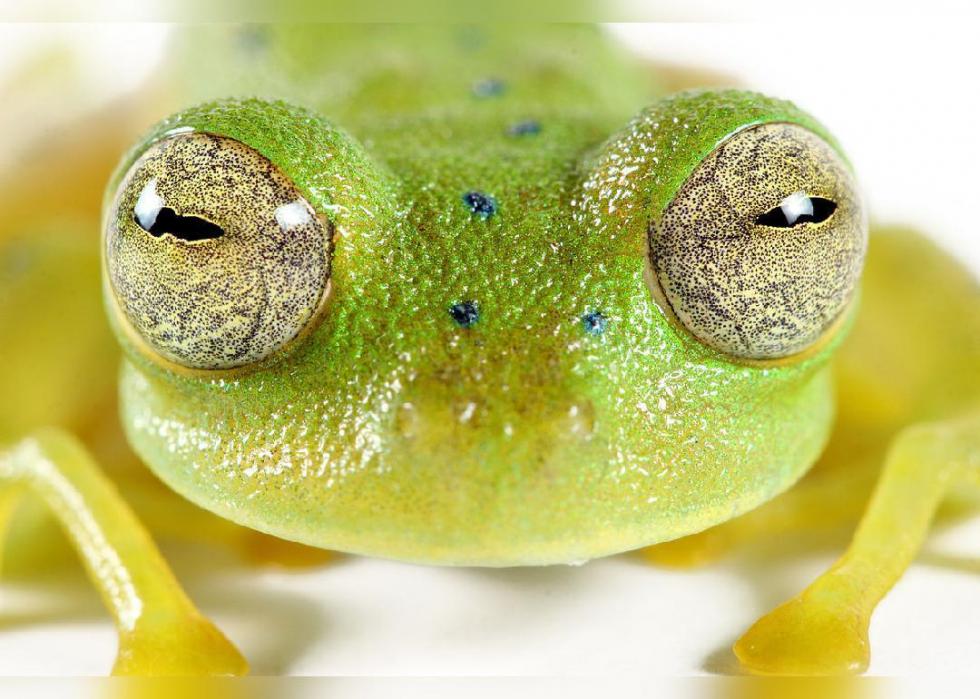
38 / 50
Santiago Ron // Wikimedia Commons // Pictured: Nymphargus cochranae
Santa Rosa cochran frog
- Scientific name: Nymphargus megacheirus
- Red List status: Endangered
- Geographic range: Republic of colombia, Ecuador
- Threatened by: Residential & commercial development, agriculture & aquaculture, biological resource apply, invasive non-native/alien species/diseases, pollution, climatic change & severe weather
- Electric current conservation efforts: Conservation sites identified, occurs in at least one protected area
- Citation: Wilmar Bolívar, Luis A. Coloma, Santiago Ron, Ana Almendáriz, Taran Grant 2004. Nymphargus megacheirus. The IUCN Red Listing of Threatened Species 2004: eastward.T54969A11233360.
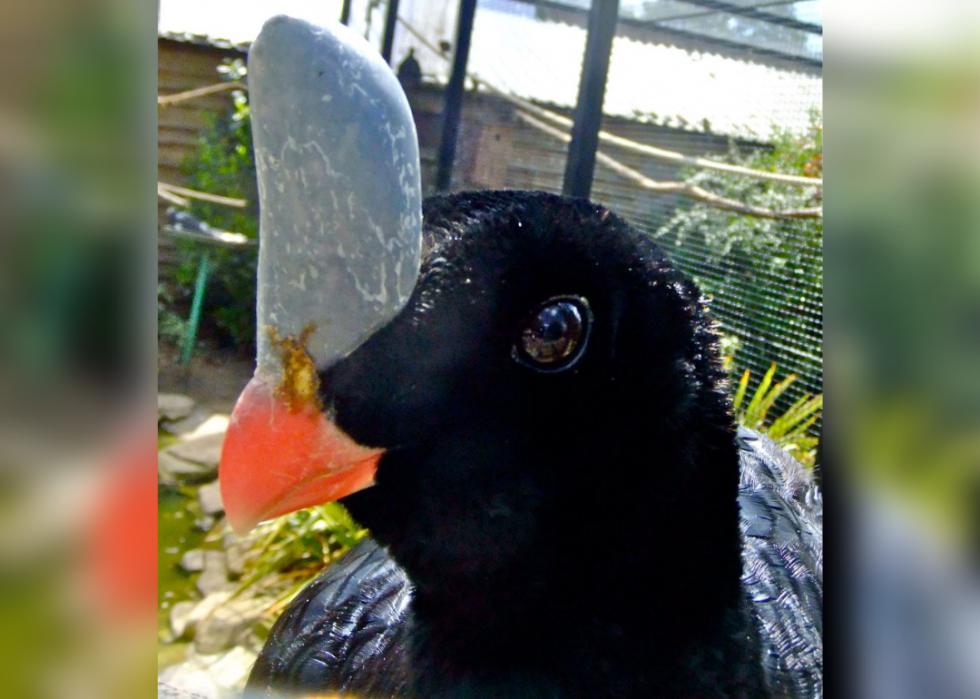
39 / l
Unknown // Wikimedia Commons
Horned curassow
- Scientific name: Pauxi unicornis
- Cerise List condition: Critically endangered
- Geographic range: Republic of bolivia
- Threatened by: Agronomics & aquaculture, energy production & mining, transportation & service corridors, biological resource use, climatic change & severe weather condition
- Current conservation efforts: Activity recovery plan, conservation sites identified, occurs in at least ane protected area, recent didactics & awareness programs
- Citation: BirdLife International 2022. Pauxi unicornis (amended version of 2016 assessment). The IUCN Ruby-red List of Threatened Species 2022: e.T45090397A126746836.
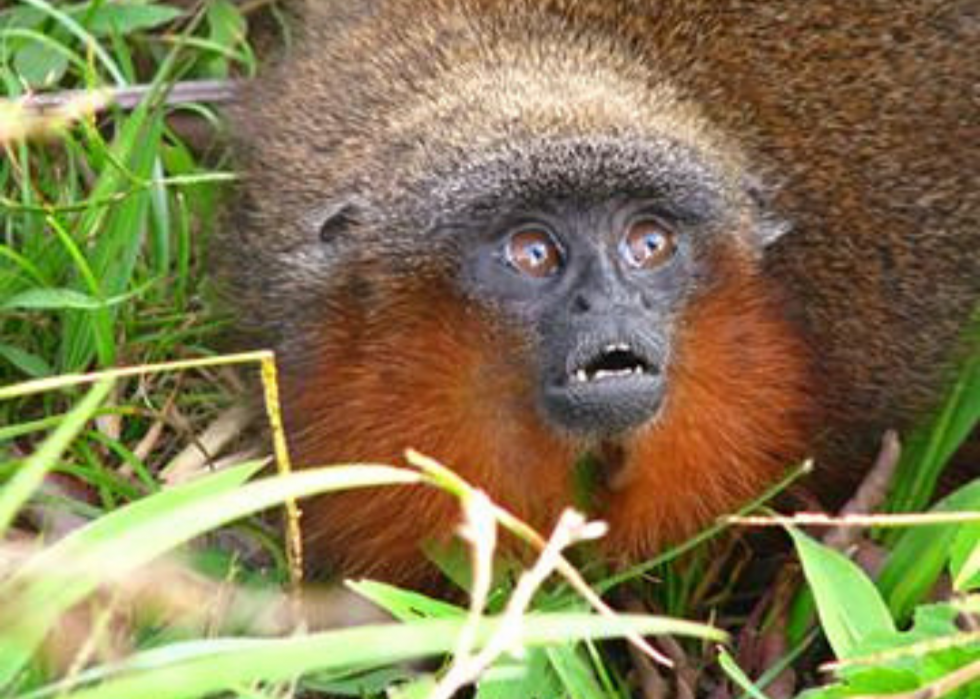
40 / l
Unknown // Wikimedia Commons
Caquetá tití monkey
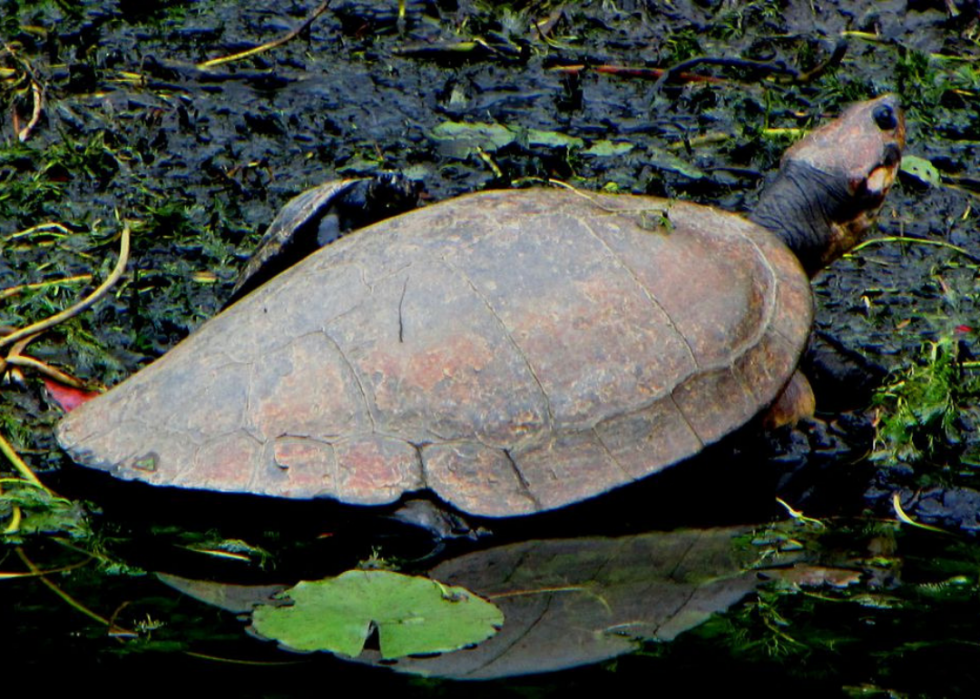
41 / 50
D. Gordon E. Robertson // Wikimedia Commons
Magdalena river turtle
- Scientific name: Podocnemis lewyana
- Scarlet List status: Critically endangered
- Geographic range: Colombia
- Threatened by: Agriculture & aquaculture, biological resource apply, natural arrangement modifications
- Current conservation efforts: None
- Citation: Páez, V., Gallego-Garcia, N. & Restrepo, A. 2016. Podocnemis lewyana. The IUCN Red List of Threatened Species 2016: eastward.T17823A1528580.
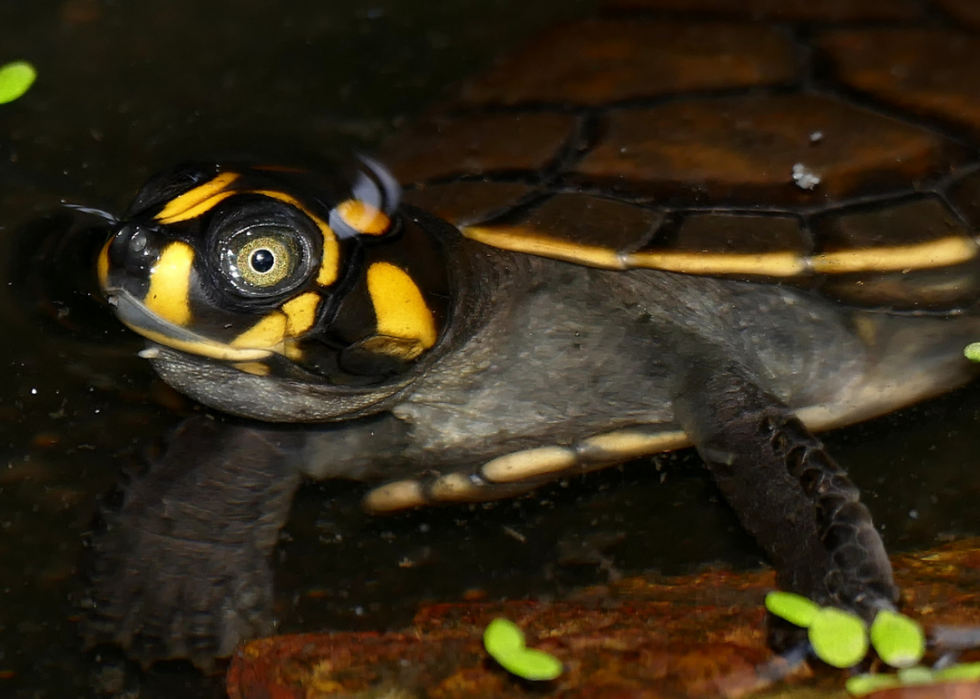
42 / 50
Yellow-spotted river turtle
- Scientific proper name: Podocnemis unifilis
- Red Listing status: Vulnerable
- Geographic range: Bolivia, Brazil, Colombia, Ecuador, French Guiana, Guyana, Peru, Suriname, Venezuela
- Threatened past: none
- Electric current conservation efforts: Included in international legislation, subject field to international direction / merchandise controls
- Citation: Tortoise & Freshwater Turtle Specialist Group 1996. Podocnemis unifilis (errata version published in 2016). The IUCN Scarlet List of Threatened Species 1996: eastward.T17825A97397562.
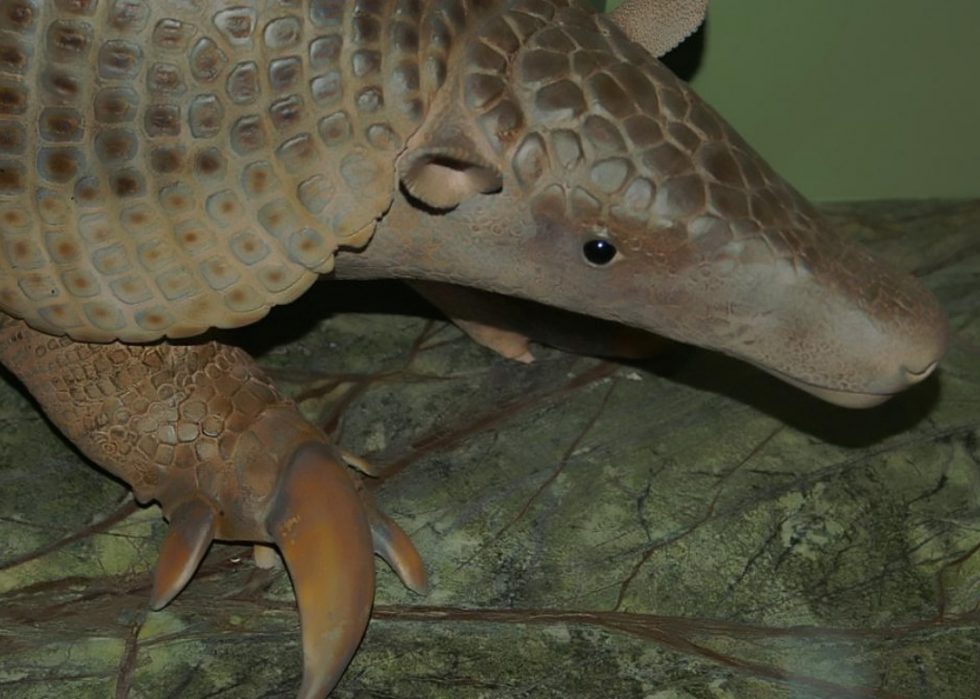
43 / fifty
David J. Stang // Wikimedia Commons
Giant armadillo
- Scientific proper noun: Priodontes maximus
- Blood-red List status: Vulnerable
- Geographic range: Argentine republic, Bolivia, Brazil, Colombia, Ecuador, French Guiana, Guyana, Paraguay, Peru, Suriname, Venezuela
- Threatened by: Agronomics & aquaculture, biological resource use
- Current conservation efforts: Conservation sites identified, occurs in at least one protected area, recent pedagogy & awareness programs, included in international legislation, subject area to international management / trade controls
- Citation: Anacleto, T.C.South., Miranda, F., Medri, I., Cuellar, E., Abba, A.M. & Superina, 1000. 2014. Priodontes maximus. The IUCN Red Listing of Threatened Species 2014: e.T18144A47442343.
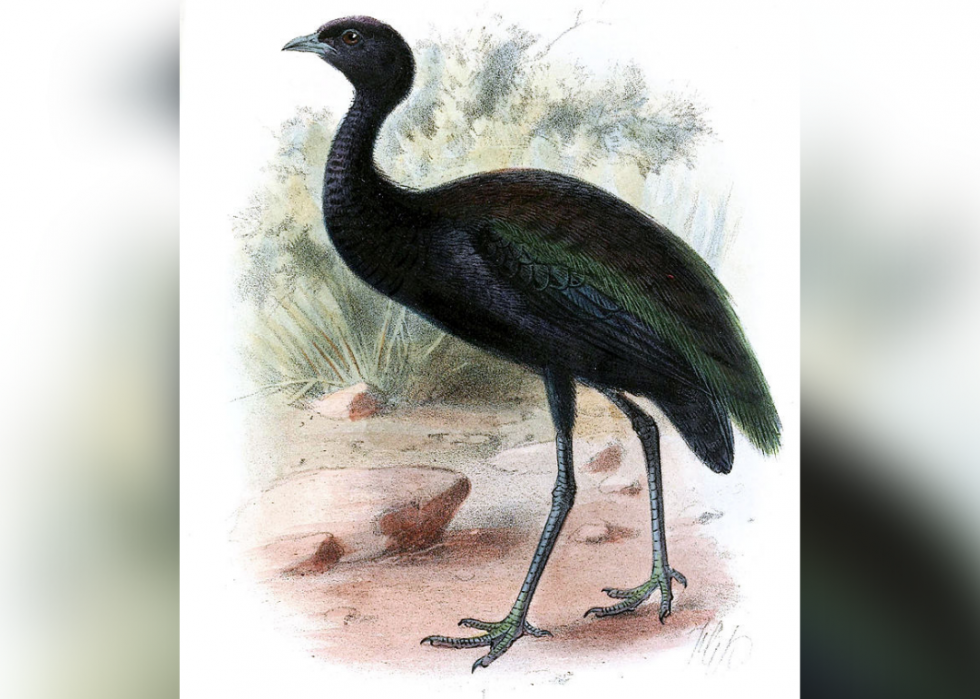
44 / 50
John Gerrard Keulemans // Wikimedia Commons
Black-winged trumpeter
- Scientific name: Psophia obscura
- Crimson List status: Critically endangered
- Geographic range: Brazil
- Threatened by: Agriculture & aquaculture, biological resource utilise
- Current conservation efforts: Conservation sites identified, occurs in at least ane protected area
- Citation: BirdLife International 2022. Psophia obscura (amended version of 2016 cess). The IUCN Ruby List of Threatened Species 2022: e.T45470702A125706121.
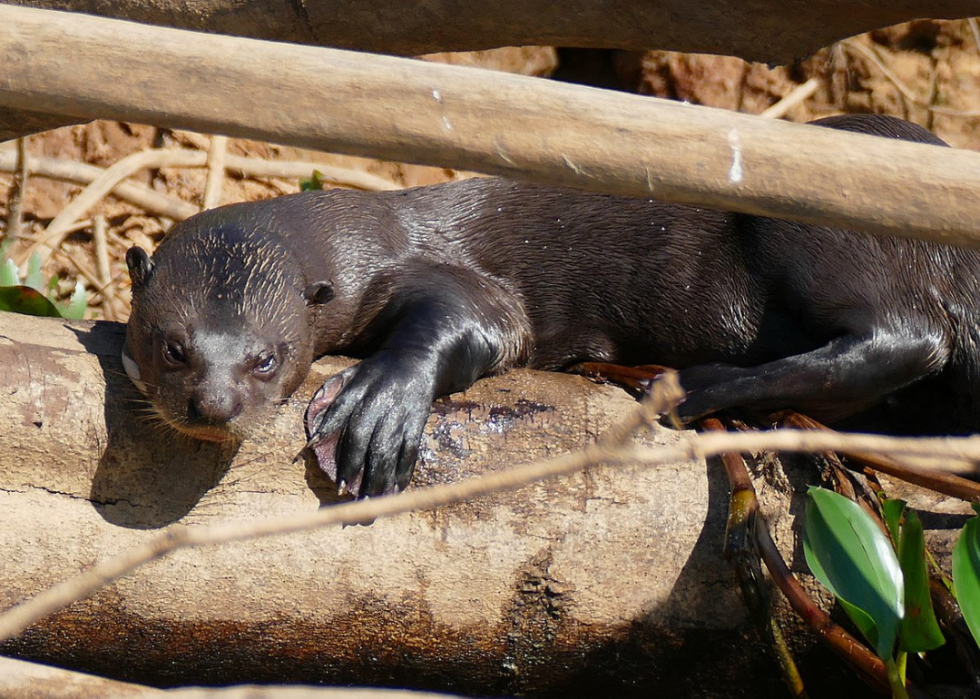
45 / 50
Bernard DUPONT // Wikimedia Eatables
Giant otter
- Scientific name: Pteronura brasiliensis
- Red List status: Endangered
- Geographic range: Bolivia, Brazil, Colombia, Ecuador, French Guiana, Guyana, Paraguay, Peru, Suriname, Venezuela
- Threatened past: Residential & commercial development, agriculture & aquaculture, energy production & mining, transportation & service corridors, biological resource employ, invasive & other problematic species/genes/diseases, pollution
- Current conservation efforts: Conservation sites identified, occurs in at to the lowest degree one protected area, contempo educational activity & awareness programs, included in international legislation, subject to whatsoever international direction / trade controls
- Citation: Groenendijk, J., Duplaix, N., Marmontel, M., Van Damme, P. & Schenck, C. 2015. Pteronura brasiliensis. The IUCN Red List of Threatened Species 2015: e.T18711A21938411.
You may also similar: Fastest-warming cities in the U.S.
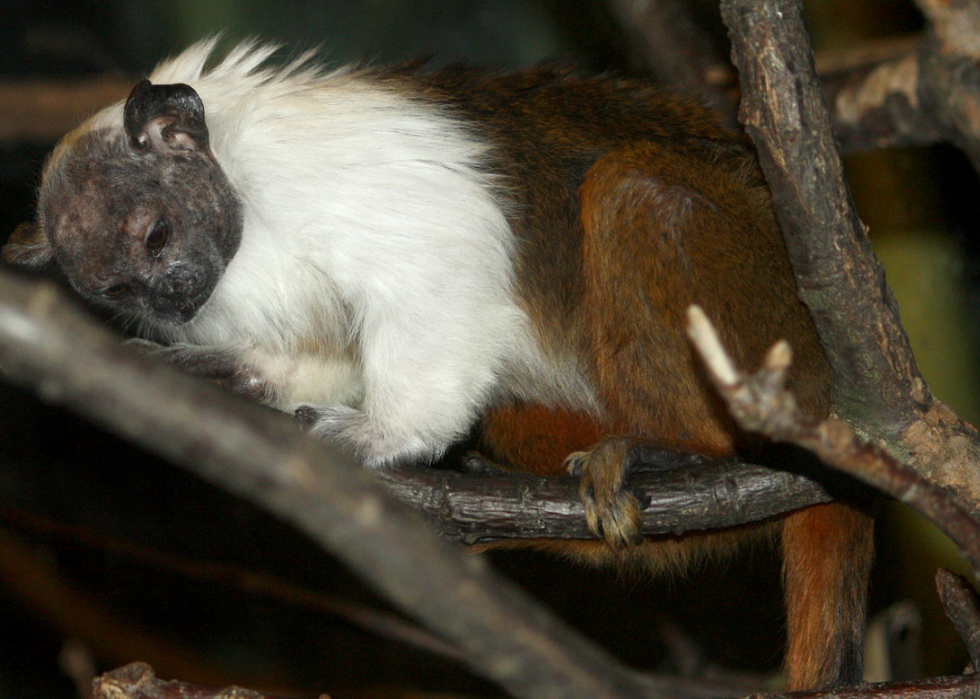
46 / 50
Postdlf // Wikimedia Commons
Saguinus bicolor
- Scientific name: Saguinus bicolor
- Red List status: Endangered
- Geographic range: Brazil (Amazonas)
- Threatened by: Residential & commercial development, agronomics & aquaculture, transportation & service corridors, biological resource use, invasive & other problematic species/genes/diseases
- Electric current conservation efforts: Conservation sites identified, subject to ex-situ conservation, subject to contempo education & awareness programs, included in international legislation, field of study to any international management / merchandise controls
- Citation: Mittermeier, R.A., Boubli, J.-P., Subirá, R. & Rylands, A.B. 2008. Saguinus bicolor. The IUCN Cherry-red List of Threatened Species 2008: e.T40644A10348136.
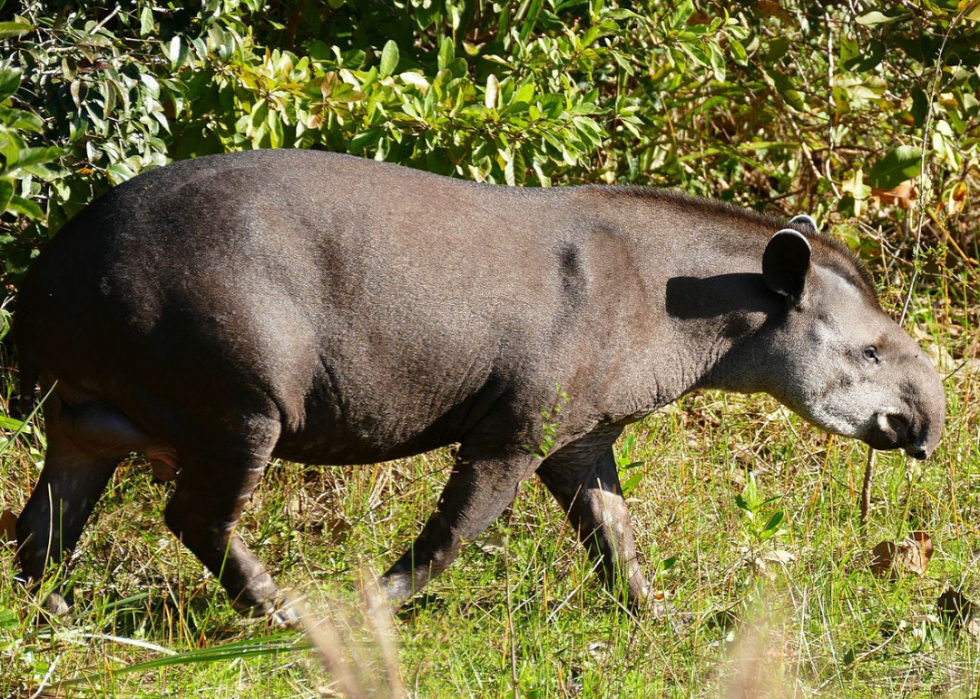
47 / 50
Bernard DUPONT // Wikimedia Commons
Lowland tapir
- Scientific name: Tapirus terrestris
- Cerise List status: Vulnerable
- Geographic range: Argentina, Republic of bolivia, Brazil, Colombia, Ecuador, French Guiana, Guyana, Paraguay, Republic of peru, Suriname, Venezuela
- Threatened by: Residential & commercial development, agronomics & aquaculture, biological resource use
- Current conservation efforts: Conservation sites identified, included in international legislation, subject field to any international management / trade controls
- Citation: Varela, D., Flesher, Grand., Cartes, J.L., de Bustos, S., Chalukian, S., Ayala, K. & Richard-Hansen, C. 2022. Tapirus terrestris. The IUCN Carmine List of Threatened Species 2022: e.T21474A45174127.
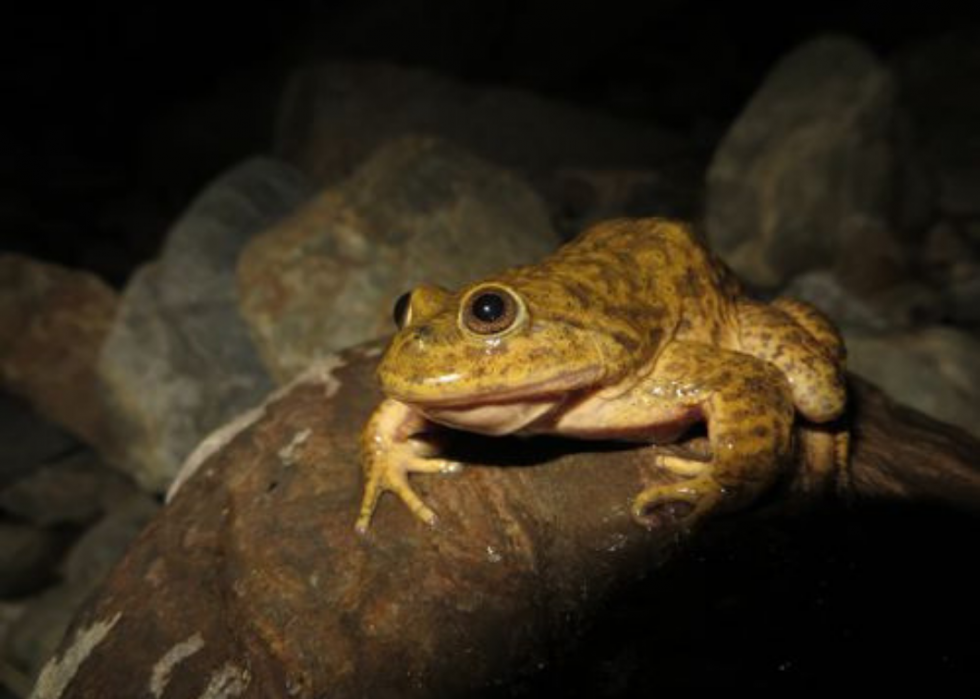
48 / 50
sophia_b_lavayen // iNaturalist
Telmatobius hintoni
- Scientific name: Telmatobius hintoni
- Red List status: Vulnerable
- Geographic range: Bolivia
- Threatened by: Biological resource use, pollution
- Electric current conservation efforts: Conservation sites identified
- Citation: Ignacio De la Riva 2010. Telmatobius hintoni. The IUCN Red List of Threatened Species 2010: e.T136017A4229613.
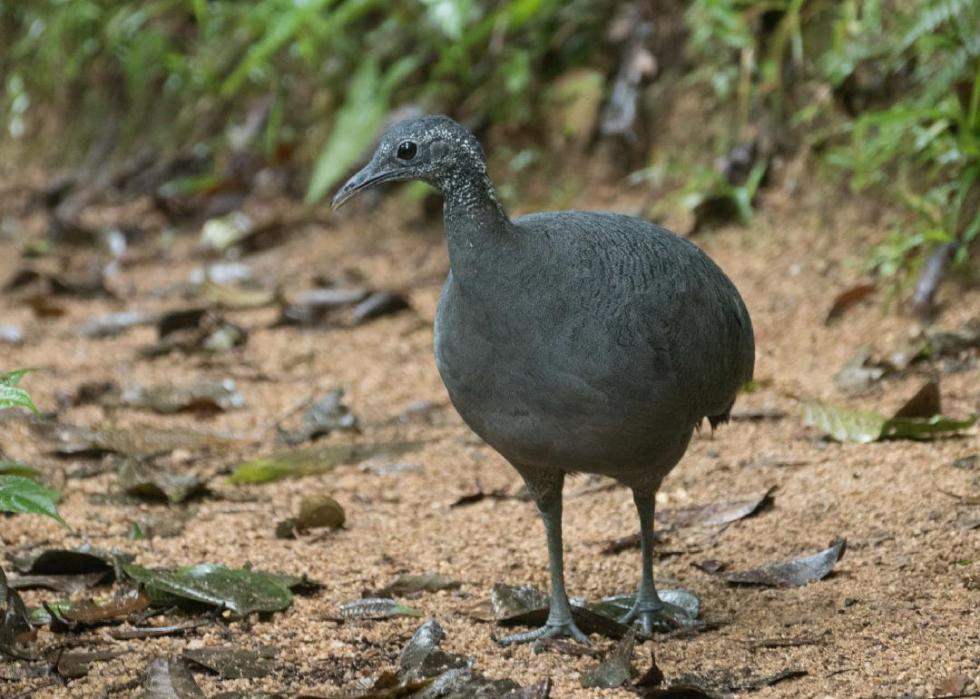
49 / 50
mattclark72 // iNaturalist // Pictured: Gray Tinamou
Black tinamou
- Scientific name: Tinamus osgoodi
- Scarlet Listing status: Vulnerable
- Geographic range: Bolivia (resident), Republic of colombia, Republic of peru (breeding), Ecuador (seasonal)
- Threatened past: Agriculture & aquaculture, energy product & mining, biological resource use
- Current conservation efforts: Conservation sites identified, occurs in at to the lowest degree 1 protected expanse
- Citation: BirdLife International 2016. Tinamus osgoodi. The IUCN Red Listing of Threatened Species 2016: due east.T22678145A92757567.
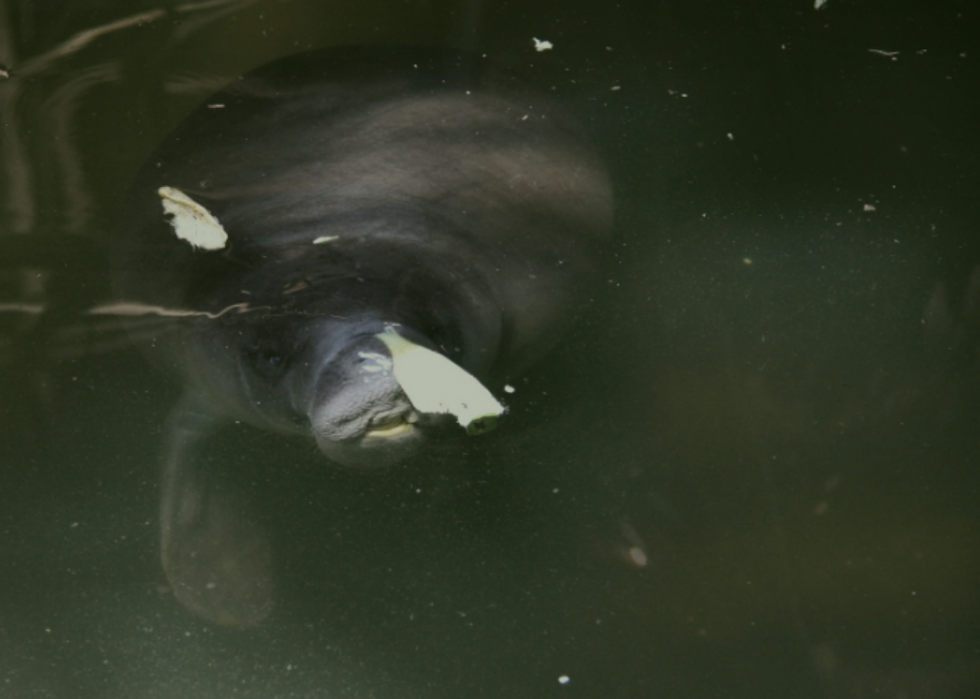
50 / l
Dirk Meyer // Wikimedia Commons
Amazonian manatee
- Scientific name: Trichechus inunguis
- Cerise Listing status: Vulnerable
- Geographic range: Brazil, Colombia, Ecuador, Republic of peru
- Threatened by: Residential & commercial development, agriculture & aquaculture, free energy production & mining, transportation & service corridors, biological resource apply, human being intrusions & disturbnce, natural system modifications, pollution, climate change & severe conditions
- Current conservation efforts: Conservation sites identified, surface area based regional management plan, occurs in at least 1 protected expanse, subject to ex-situ conservation, contempo educational activity & awareness programs, included in international legislation, bailiwick to whatever international management / trade controls
- Commendation: Marmontel, M., de Souza, D. & Kendall, S. 2016. Trichechus inunguis. The IUCN Blood-red List of Threatened Species 2016: e.T22102A43793736.
You lot may likewise like: Can you lot solve these real 'Jeopardy!' clues virtually the oceans?
Trending Now
© Stacker 2022. All rights reserved.
What Animals Live in the Amazon Rainforest River
Source: https://stacker.com/stories/3452/50-endangered-species-only-live-amazon-rainforest